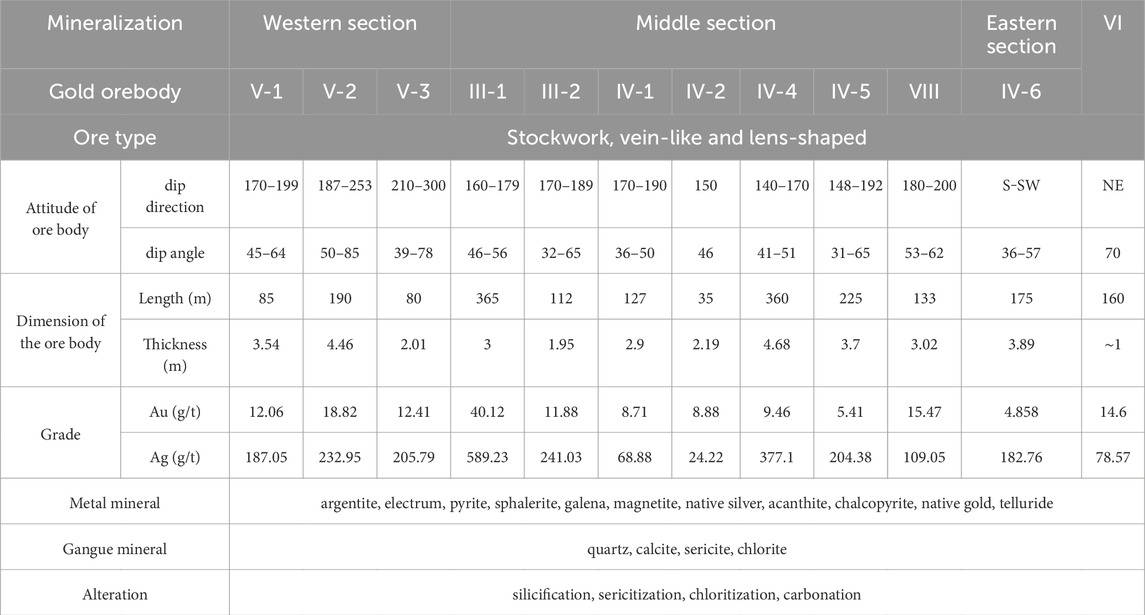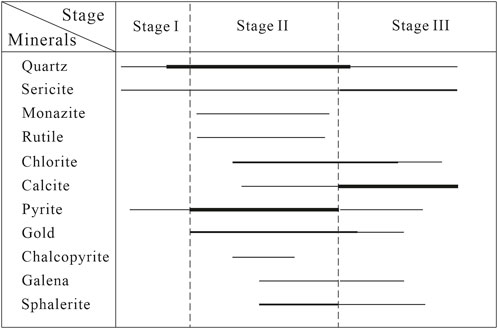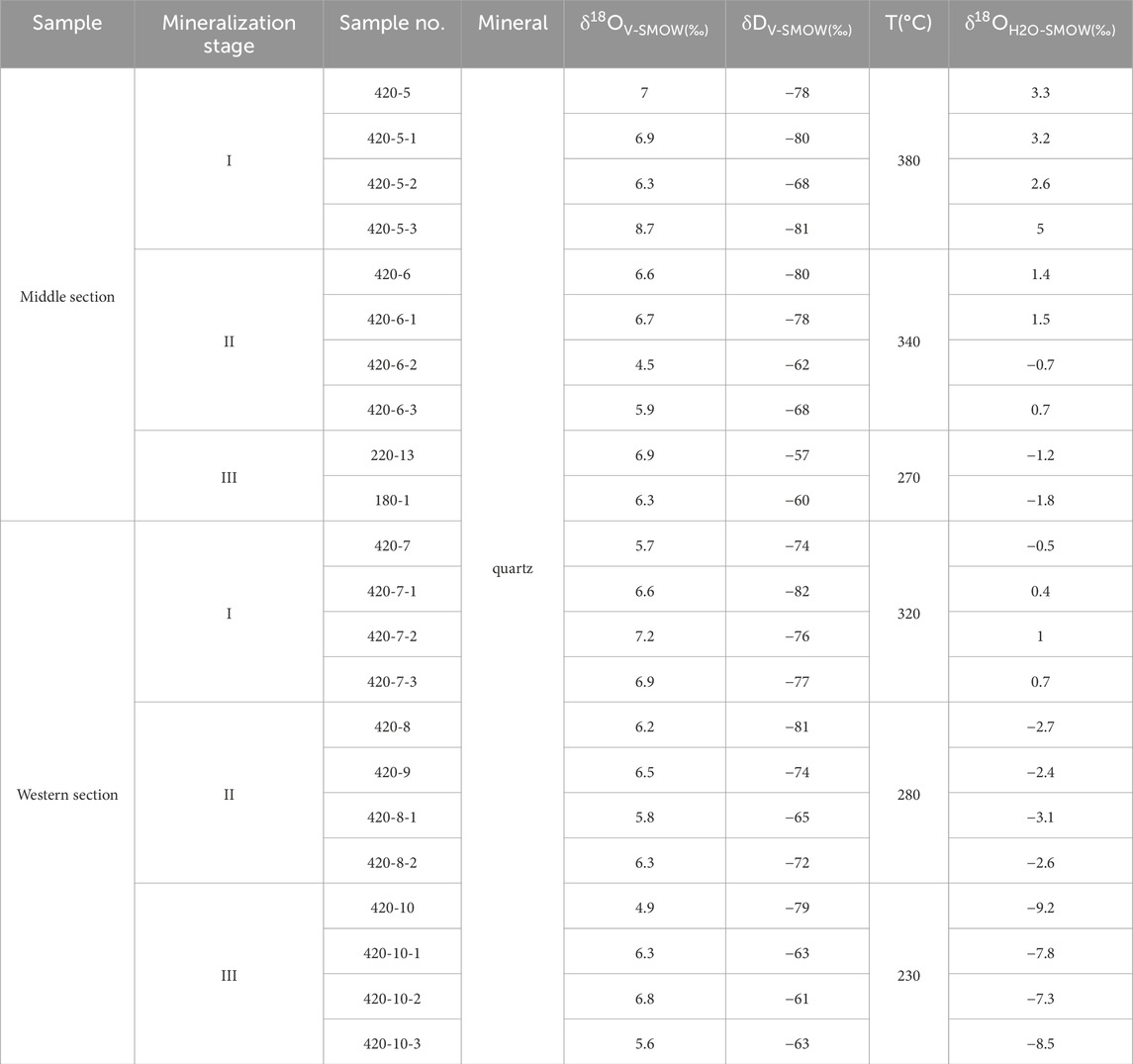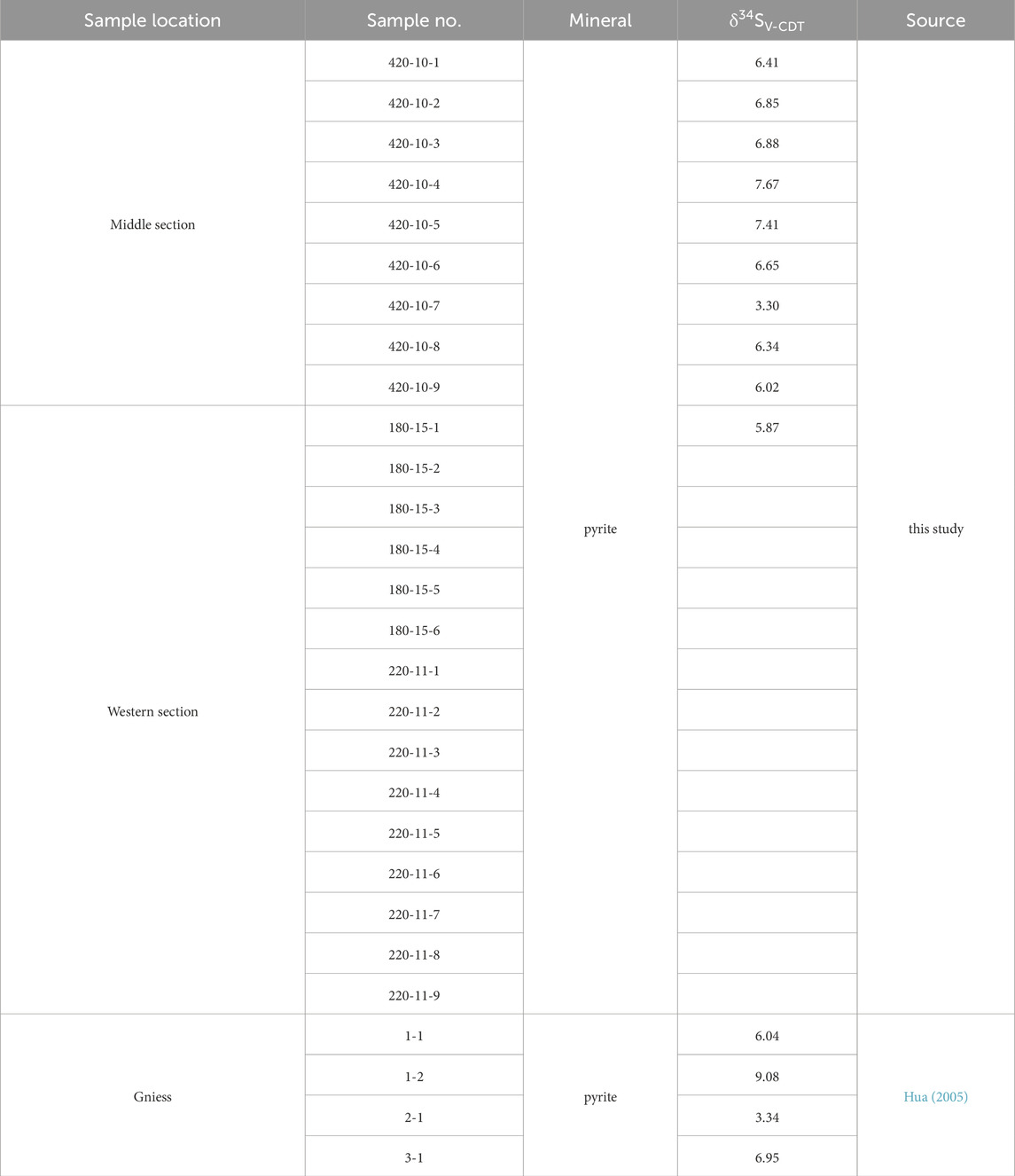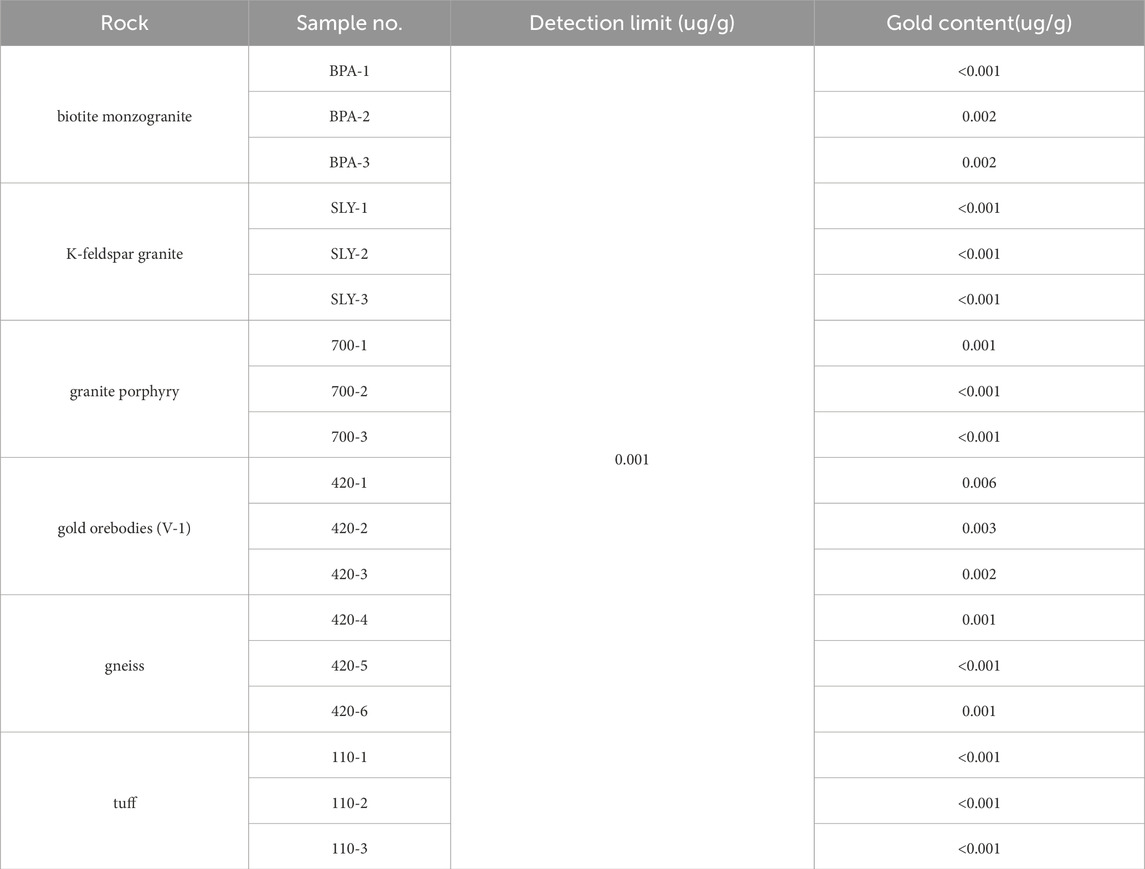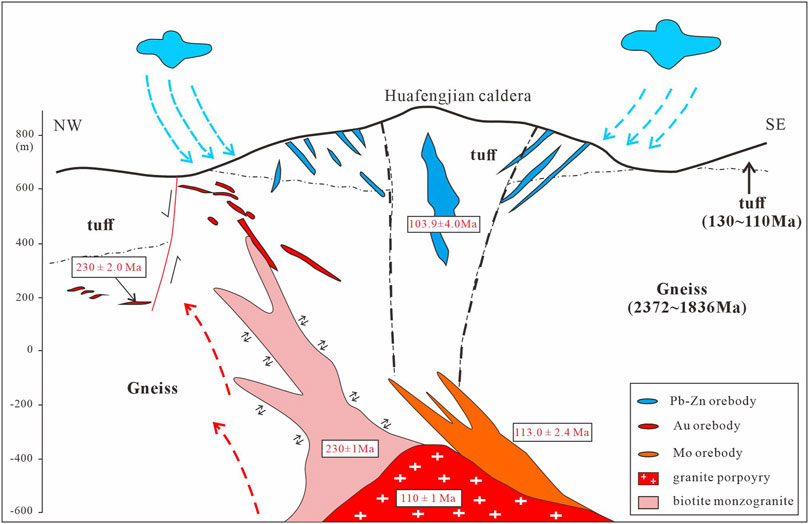- 1Development and Research Center, China Geological Survey, Beijing, China
- 2School of Earth Science and Resources, China University of Geosciences, Beijing, China
- 3Key Laboratory of Metallogeny and Mineral Assessment, Ministry of Natural Resources, Institute of Mineral Resources, Chinese Academy of Geological Sciences, Beijing, China
- 4Shandong Provincial Department of Natural Resources, Shandong Institute of Geological Sciences, Jinan, Shandong, China
- 5Institute of Mineral Resources Research, China Metallurgical Geology Bureau, Beijing, China
The Zhilingtou gold deposit in Zhejiang Province, China, is located in the Qin-Hang metallogenic belt and hosted within Paleoproterozoic Badu Group gneiss. Geologic and isotopic analyses reveal that the gold mineralization is associated with a concealed biotite monzogranite (230 ± 1 Ma) and developed along the contact zone with gneiss. Ore-forming fluids, characterized by moderate—high temperatures (237–376°C) and low salinities (1.90–6.72 wt.% NaCl eqv), originated from a magmatic source and were later diluted by meteoric water, leading to gold precipitation. Pb isotopes indicate a crustal origin for lead, closely related to the Badu Group gneiss. The deposit likely formed in a late Triassic postcollisional extensional setting during the Indosinian orogeny involving the South China and North China blocks, suggesting an intrusion-related gold deposit (IRGD) model with excellent potential for further exploration.
1 Introduction
Gold deposits are often found to be spatially associated with various granitoid bodies around the world. When detailed geochronological analyses are conducted, it becomes evident that these gold deposits and the granitoid intrusions believed to be productive often form at the same time (Cameron and Hattori, 1987; Goldfarb et al., 2005; Mair et al., 2011; Li et al., 2020; 2023; Liang et al., 2021; Yu et al., 2022). Chronology and stable isotope studies suggest that such intrusions, particularly I-type granitoids, play an essential role in the mineralization process, as they provide both the ore-forming fluids and the metals that contribute to the formation of gold deposits (Cameron and Hattori, 1987; Goldfarb et al., 2005; Mair et al., 2011; Liang et al., 2021; Cai et al., 2021; Cai et al., 2024). These gold deposits, often termed intrusion-related gold deposits (IRGDs), exhibit certain characteristics that overlap with those of orogenic gold deposits (Thompson et al., 1999; Lang et al., 2000). This overlap has caused some confusion in distinguishing the two types of deposits. Orogenic gold deposits generally result from fluids and metals released from coeval intrusive magmas or through the metamorphic devolatilization of volcanic-sedimentary rocks (Goldfarb et al., 2001; Groves et al., 2020; Patten et al., 2020). Although IRGDs form through similar ore-forming fluids, they differ by exhibiting multiple styles of hydrothermal mineralization that are directly related to the emplacement and cooling of granitic plutons (Hart et al., 2004; Mernagh et al., 2007).
The Qin-Hang metallogenic belt in South China Block (SCB), which is a large Cu–Au polymetallic ore distric that includes several large or giant Cu–Au deposits (e.g., Dexing porphyry Cu deposit, Yinshan epithermal Cu–Au–Pb–Zn–Ag deposit, YongPing porphyry Cu deposit, Jinshan orogenic Au deposit; Ni et al., 2005; Wang et al., 2012; Zhao et al., 2013; Wang et al., 2015). Recent studies have advanced the understanding of the region’s tectonomagmatic and metallogenic evolution. The numerous deposits within the SCB are closely related to Indosinian and Yanshanian intrusive rocks. The Zhilingtou gold deposit, which exemplifies a lode gold deposit, was identified in 1965 by a geophysical exploration team from the Zhejiang Provincial Bureau of Geology and Mineral Resources. This study presents findings from microthermometric analyses of fluid inclusions (FIs), along with oxygen and hydrogen isotope analyses of quartz, sulfur, and lead isotope analyses of pyrite. The newly acquired data provide new insights into the origin of the ore fluids and metals elucidate the roles of fluid-rock interaction and fluid mixing in gold deposition, and improve our understanding of the genesis and mineralization model of the intrusion-related gold deposit in comparable geologic settings elsewhere.
2 Geological setting
The SCB is a geologically complex region in South China formed by the amalgamation of the Yangtze and Cathaysia blocks along the Jiangshan-Shaoxing Fault during the Neoproterozoic Jiangnan Orogeny. The region subsequently underwent significant continental rifting during the Nanhua Rift, which led to extensive sedimentation in the Nanhua Basin. In the late Paleozoic, the evolution of the Paleo-Tethys Ocean began to impact the SCB, and the Triassic Indosinian Orogeny further modified its tectonic framework. During this period, a major collision between the SCB and North China Block occurred along the Qinling-Dabie orogenic belt. During the late Mesozoic, the SCB experienced extensive tectono-magmatic activities, resulting in the formation of numerous large-scale metal deposits of W, Sn, Cu, Au, Mo, Pb, Zn, Ag, as well as a series of non-metallic deposits such as fluorite and pyrophyllite (Figure 1; Hua, 2005; Mao et al., 2011, Mao et al., 2013; Sun et al., 2012). Mao et al. (2007), Mao et al. (2008) summarized the mineral deposits in the region and divided the formation ages of Mesozoic deposits in South China into the following three stages: the Late Triassic (230–210 Ma) W–Sn–Nb–Ta deposits associated with peraluminous biotite granite, the Middle–Late Jurassic (170–150 Ma) porphyry–skarn Cu deposits (170–160 Ma) related to I-type or adakitic rocks and W–Sn polymetallic deposits (160–150 Ma) associated with highly fractionated granite, and the Early–Middle Cretaceous (134–80 Ma, with a peak mineralization period from 100 to 90 Ma) epithermal low-sulfidation Cu–Ag–Au deposits and W–Sn–Cu polymetallic deposits related to granite.
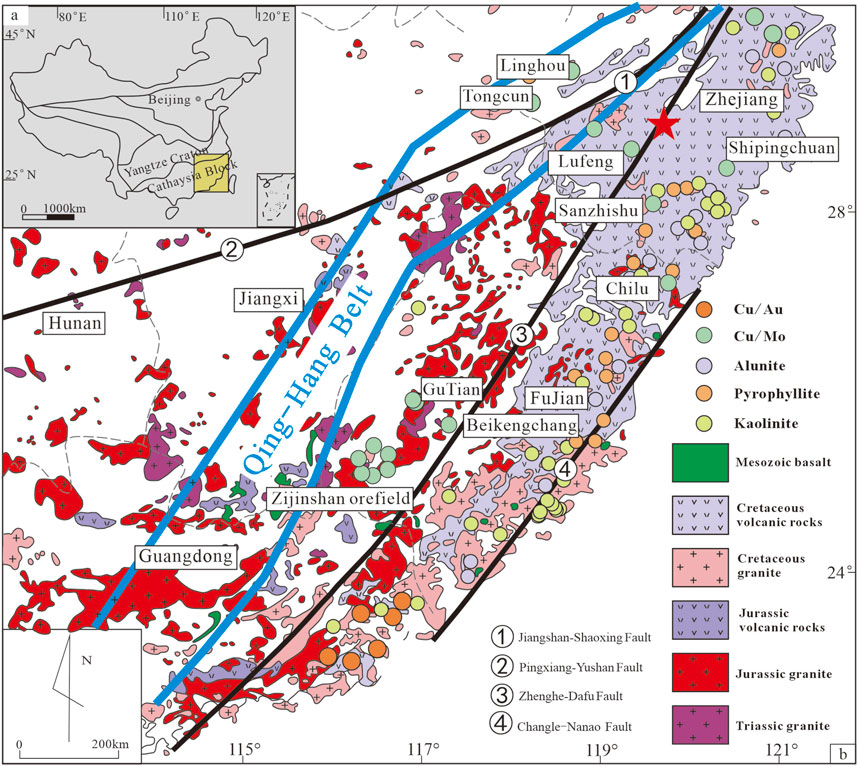
Figure 1. (a) Tectonic sketch map of SE China and (b) geologic map showing the distribution of Mesozoic granitoids and significant deposits in the southeastern coastal metallogenic belt (modified after Zhou et al., 2006; Li et al., 2016; Liu et al., 2018).
In recent years, numerous scholars have conducted extensive research on the tectonic-magmatic-sedimentary activities of the Indosinian orogeny in South China (e.g., Ren, 1984; Hsü et al., 1990; Guo, 1992; Wang et al., 2001; Zhou et al., 2006; 2015; Zhang et al., 2009; Bai et al., 2012). Wang et al. (2001) correlated the Triassic granites with the collision of the North China and South China blocks. Zhou et al. (2006) further suggested that the collision time can be inferred to be in the Early Triassic, consistent with the formation time of the Songma Suture. Zhang et al. (2009) argued that the near east-west trending fold belt in South China during the Indosinian period is closely related to the collision of the North-South blocks of the South China continent. The Middle to Late Triassic was a post-collisional environment, with Late Triassic tectonic deformation and magmatic rocks formed in the tectonic setting of the multi-block convergence of South China, North China, Indochina, and the Paleo-Pacific (Wang et al., 2013; Gao et al., 2017). This environment led to a series of Late Triassic low-temperature gold and lead-zinc deposits in the Southwestern Yangtze Block of South China, under the intraplate orogenic tectonic environment (Hu et al., 2017). The Indosinian orogeny caused folding and thickening of the Devonian-Triassic strata in the SCB, resulting in the widespread distribution of peraluminous, potassic-rich granites (A/CNK >1.00, K2O > 3.0%) in the region (Guo et al., 2012; Wang et al., 2013). These granites have isotopic compositions similar to those of South China gneissic rocks (Jia, 1998; Chen and Jahn, 1998), and their formation may be related to the dehydration melting of muscovite and biotite minerals in the lower-middle crustal metamorphic rocks (Deng et al., 1995; Jia, 1998).
The Zhilingtou gold deposit is located in southwestern Zhejiang, Cathaysia Block. The basement rocks predominantly consist of the Proterozoic Badu, Longquan, and Chencai Groups, of which the Badu Group is the oldest known rock in the Cathaysia Block (ca. 2.5 Ga, Li et al., 2010; Shu et al., 2011; Yu et al., 2012). The cover lithologies are primarily composed of Cretaceous volcanic rocks, including the Dashuang, Gaowu, Xishantou, Chawan, Jiuliping, Guantou, Chaochuan, and Fangyan Groups (Bureau of Geology and Mineral Resources of Zhejiang Province, 1989). The volcanic rocks mainly belong to a calc-alkaline series, consisting primarily of andesite, dacite, and rhyolite. These rocks range from ∼140 to 110 Ma for the older group and from 110 to 85 Ma for the younger group (Lapierre et al., 1997; He and Xu, 2012). Both volcanic and intrusive rocks are distributed along several regional faults, which are oriented NE–SW, NNE–SSW, and NW–SE.
3 Ore deposit geology
The Zhilingtou gold deposit has a long mining history, dating back to the Tang Dynasty. Lead-zinc and molybdenum deposits were subsequently discovered in the area. The Zhilingtou deposit proved reserves of 26.1 t Au (average grade = 11 g/t) and 594 t Ag (average grade = 255 g/t; Ni et al., 2012). Pb–Zn and Mo mineralization with resources of 0.24 Mt Pb–Zn at an average grade of 2% and more than 0.06 Mt Mo at an average grade of 0.07% Mo. The abundance and diversity of resources have attracted significant attention from scholars and experts. Re–Os dating of molybdenite constrains the Mo mineralization at 113.0 ± 2.4 Ma and Ar–Ar dating on sphalerite shows that the Pb–Zn mineralization likely formed at 113.9 ± 4.0 Ma (Wang, 2014). The Au mineralization age can be constrained at 230 ± 2.0 Ma using hydrothermal rutile and monazite U-Pb ages (Liu et al., 2025a). The spatial relationships between Au, Pb–Zn, and Mo mineralization in the Zhilingtou area are characterized by distinct zonation and structural control. The Mo mineralization is primarily associated with porphyry Mo deposits in the central and deeper parts of the system, hosted within granite porphyry and biotite–plagioclase gneiss. The Au–Ag mineralization occurs in the shallower levels and peripheral areas, hosted by late Paleoproterozoic gneiss and controlled by concealed faults associated with the Huafengjian volcanic edifice. The Pb–Zn mineralization is distributed within the Huafengjian caldera, hosted by rhyolite and gneiss. The Badu Group consists of biotite-plagioclase gneiss, mica schist, and migmatite. The rocks are characterized by complex deformation and metamorphism, intense migmatization, and belong to the amphibolite-facies zone. The Dashuang Group comprises mainly medium-to coarse-grained quartz sandstone, rhyolitic tuff, and rhyolitic breccia. LA‒ICP‒MS zircon U‒Pb dating results indicate that the Dashuang Group formed between 127 and 110 Ma (Ni et al., 2012).
The tectonic structures in the Zhilingtou area can be categorized primarily into volcanic edifices and local faults, both of which play crucial roles in the mineralization processes within the mining area and the spatial distribution of orebodies. The local faults primarily display E‒W and NE‒SW orientations, which are correlated with the majority of gold deposits. By contrast, most NE‒SW faults intersect the ore bodies, suggesting that their formation occurred subsequent to the mineralization event. A network of circular and radial faults around the Huafengjian volcanic edifice has developed in the vicinity, influencing the distribution of vein-type lead-zinc mineralization. This edifice manifests as an elliptical depression trending N‒S, encompassing an area of 2 km2. The central volcanic vent is characterized by the presence of rhyolitic volcaniclastic rocks, rhyolite porphyry, and cryptoexploded brecciated lead–zinc mineralization, which penetrate significantly into the molybdenum-bearing granite porphyry.
In addition to the Cretaceous Dashuang volcanic rocks, the area features coeval granite porphyry (∼110 Ma, Ni et al., 2012; Zeng et al., 2012; Liu et al., 2023) and rhyolite porphyry. The granite porphyry is located 700 m beneath the surface and is primarily composed of quartz, K-feldspar, plagioclase, and biotite, with magnetite, zircon, and apatite as accessory minerals. There is apparent Mo mineralization inside, closely related to the formation of molybdenum orebodies between 50 and 500 m depth in the mining area. In addition, the mining area has three stages of volcanic magmatic activity. These consist of (i) Triassic K-feldspar granite (230 ± 1 Ma; Liu et al., 2025b) and biotite monzogranite (230 ± 1 Ma; Liu et al., 2025b), neither of which are exposed at the surface. The biotite monzogranite is exposed at 420 m depth and is closely related to the formation of gold; (ii) the early Cretaceous altered quartz monzonitic porphyry (137 ± 1 Ma; Liu et al., 2023); (iii) the late Cretaceous felsite (98 ± 1 Ma; Hua and Liu, 2022) and the quartz monzonite (97 ± 1 Ma; Liu et al., 2023), both of which are concealed vein rocks, and the two types of rocks cut through the biotite monzogranite, gold and molybdenum orebodies.
4 Characteristics of the mineralization
Twelve orebodies have been identified in the mining area, occurring within the Badu Group and concealed beneath the volcanic rocks. The orebodies are located north of the Huafengjian volcanic edifice, with a general strike nearly E‒W and a dip toward the SW‒SE. The strike extends over 1,400 m, and the dip extends vertically to approximately 200 m. These orebodies can be divided into eastern, middle, and western sections by the F1 and F42 faults (Figures 2, 3). The western section contains three major orebodies: V-1, V-2, and V-3; the middle section contains seven major orebodies: III-1, III-2, VIII, IV-1, IV-2, IV-4, and IV-5; and the eastern section contains one primary orebody, IV-6. The VI orebody is also present within the F1 fault zone and is fault-controlled.
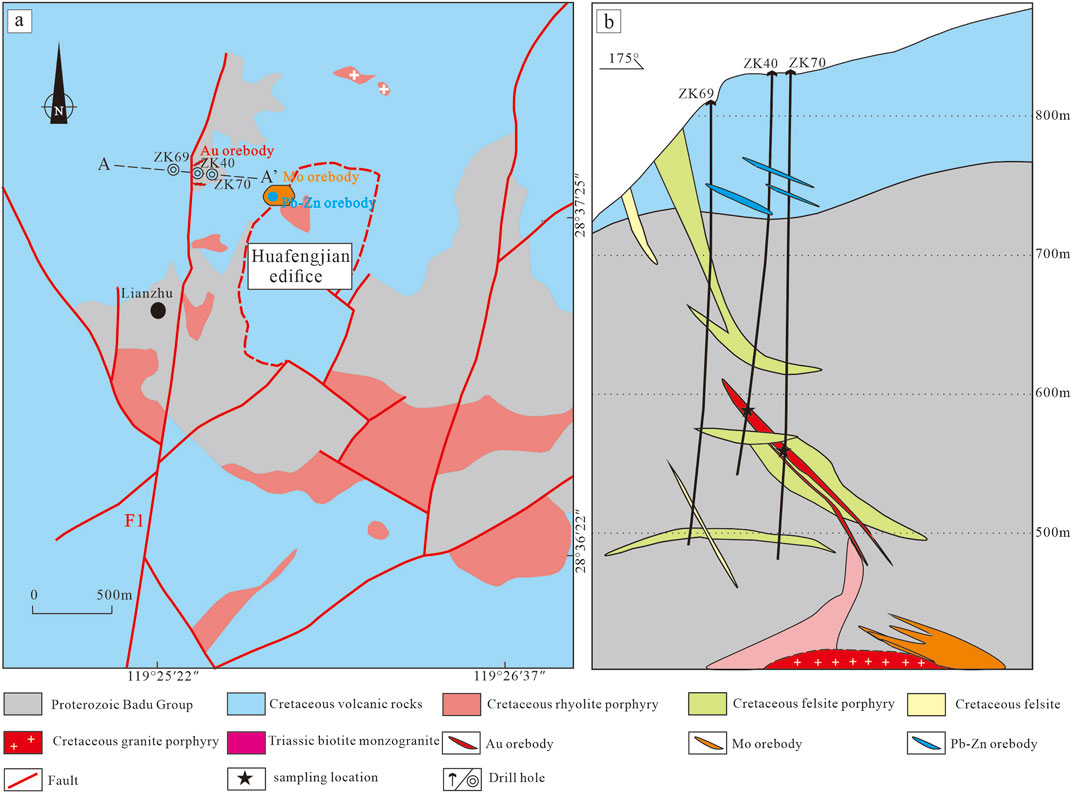
Figure 2. Geological map of the Zhilingtou deposit (a) and cross-section of Line A-A′ in the Zhilingtou gold deposit (b) (after Wang et al., 2017).
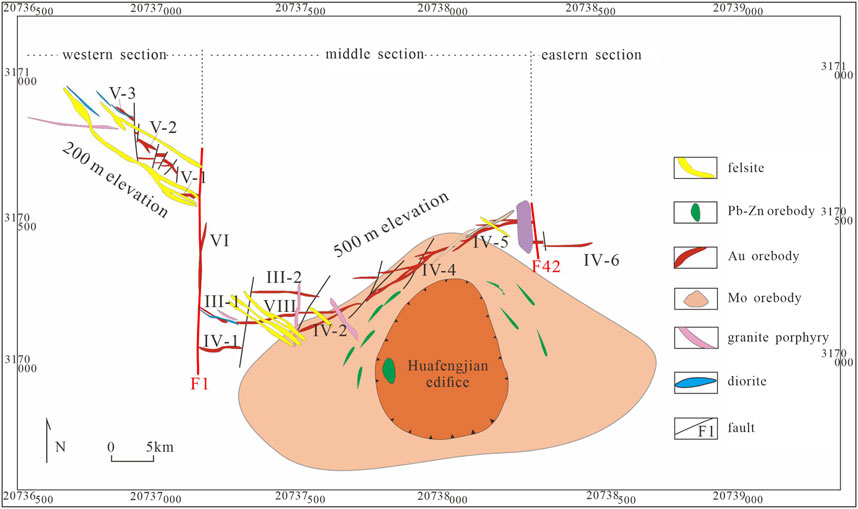
Figure 3. Spatial distribution of gold orebodies in the Zhilingtou gold deposit (after Zeng et al., 2012).
The gold orebodies predominantly occur in stockwork, vein-like, and lens-shaped forms within the Badu Group’s biotite-plagioclase gneisses. The primary minerals are argentite, electrum, pyrite, sphalerite, galena, and magnetite, with secondary minerals including native silver, acanthite, chalcopyrite, and trace amounts of native gold, telluride, and manganese sulfides. The gangue minerals are mainly quartz, sericite, chalcedony, and minor rhodochrosite. Some accessory minerals, such as rutile and monazite, are also present (Table 1; Figures 4, 5).
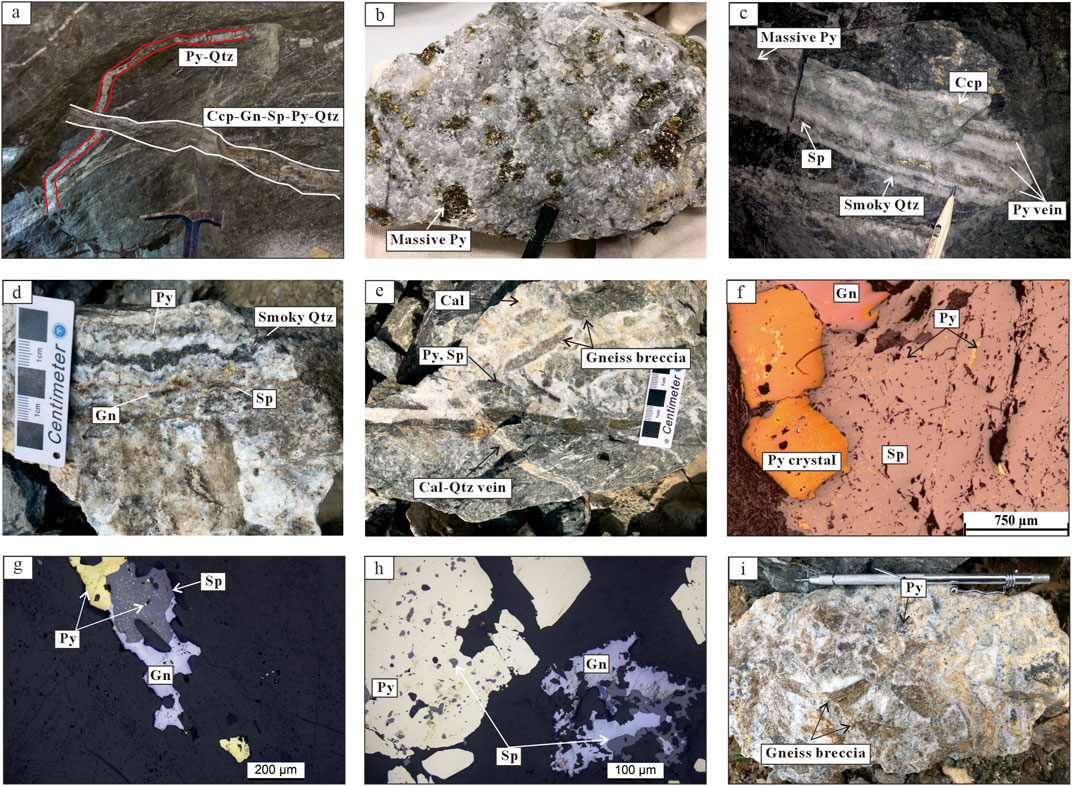
Figure 4. Ore crosscutting relationships and gold distribution characteristics of the Zhilingtou deposit. (a) Chalcopyrite + galena + sphalerite + pyrite + quartz vein (Stage II) cut pyrite + quartz vein (Stage I); (b) Pyrite occurs in quartz veins as massive aggregates; (c,d) Chalcopyrite + sphalerite + massive and vein-type pyrite occur in the smoky quartz vein (Stage II); (e) Calcite-quartz veins (Stage III) show calcite alteration and gneiss breccia; (f-h). Microscopic images show that pyrite formed simultaneously with sphalerite and galena; (i) Calcite-quartz veins (Stage III) develop calcite alteration, gneiss breccia, and pyrite crystals. Abbreviations: Cal: calcite; Qtz: quartz; Py: pyrite; Sp: sphalerite; Gn: galena; Ccp: chalcopyrite.
On the basis of field observations, hand samples, microscopic cross-cutting relationships, and mineral assemblages, the mineralization of the Zhilingtou gold deposit can be divided into three stages:
i. Pyrite–Quartz Stage (stage I): This stage represents the early phase of gold mineralization, with a mineral assemblage primarily consisting of quartz and minor pyrite. The quartz is predominantly milky-white to gray, exhibiting fine-grained textures and occurring in vein-like and stockworks alongside sulfides. Pyrite, typically coarser in grain size, often appears as aggregates (Figures 4a,b).
ii. Polymetallic sulfide -Quartz Stage (Stage II): This stage marks the main phase of gold mineralization, characterized by an assemblage of silicified quartz, pyrite, sericite, sphalerite, galena, and minor chalcopyrite and calcite. In this stage, pyrite is altered and disseminated throughout the quartz as impregnation textures (Figures 4c–h).
iii. Quartz‒Calcite Stage (Stage III): The final stage of hydrothermal evolution is characterized by a scarcity of sulfide minerals and is dominated by quartz and calcite. Occasional pyrite grains with altered morphologies are also observed. The gold grades in this stage are generally low (Figures 4e,i).
The surrounding rocks of the gold orebodies exhibit intense alteration, primarily silicification, sericitization, chloritization, and carbonation (Figure 6). The orebodies are hosted within strongly silicified zones, with silicification most closely related to the ore formation process (Figures 6a,b). During stage II of mineralization, hydrothermal fluids infiltrated and replaced the host rocks along structural fractures and minor faults, forming silicified quartz veins. These veins are typically milky-white to smoky gray or dark gray, with gold particles disseminated in impregnation textures within smoky or dark gray quartz vein fractures and interstitial spaces. The zones of intense silicification tend to correlate with higher gold grades and more abundant gold deposition. In the silicified quartz veins of Stage III, sulfides and gold are scarce, and the quartz is typically milky-white to transparent with coarser grain sizes, reflecting a weakened silicification process. Hydrothermal activity has replaced plagioclase with sericite, which appears as microsheets. Locally, alteration remnants and pseudomorphs of plagioclase and k-feldspar are observed. Dark minerals such as biotite are typically replaced by chlorite, which is often replaced by sericite (Figures 6c–f). The relationship between sericitization and mineralization is relatively weak. Carbonatization is primarily observed during Stages II and III, with the majority occurring in Stage III. It manifests predominantly as delicate calcite veins or quartz‒calcite veinlets that cut through the orebodies and surrounding rocks (Figures 6b,f). The widespread occurrence of these veins signifies that hydrothermal activity has entered its late stages.
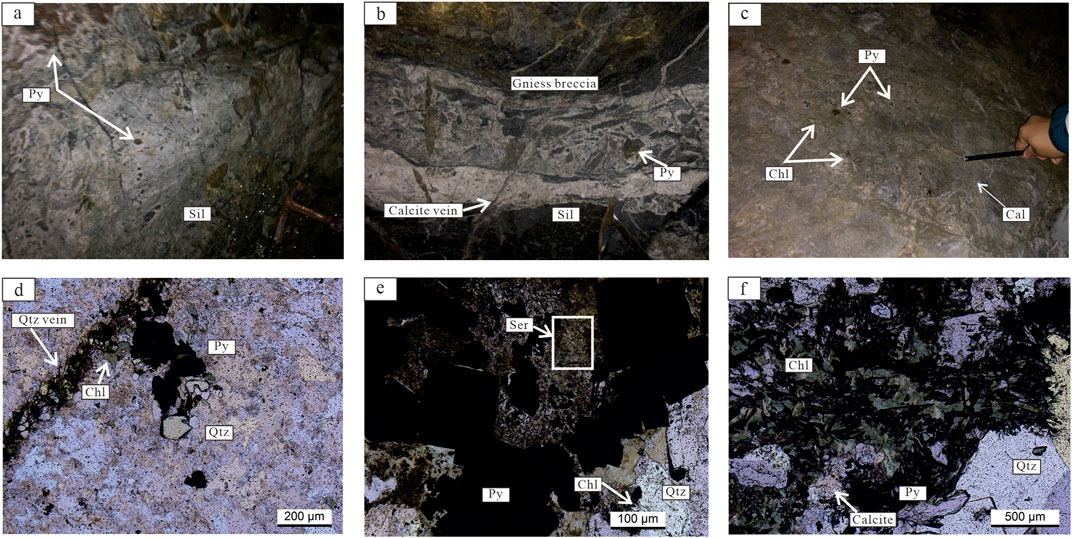
Figure 6. Representative photographs and photomicrographs showing ore-related hydrothermal alterations. (a,b). Silicification developed in the Stage I; (c-f), Sericitization, chloritization and carbonatization developed in the Stages II and III. Abbreviations: Py, pyrite; Sil, Silicification; Chl, chloritization; Ca, calcite; Qtz, quartz.
5 Sampling and analytical methods
5.1 Fluid inclusion analysis
The samples selected from the Zhilingtou gold deposit for fluid inclusion analysis were obtained from ZK404 (Figure 2b). These samples were subsequently prepared into doubly polished thin sections 0.20–0.30 mm thick for microthermometric analysis. Before analysis, the samples were immersed in acetone for 3–4 h and then dried. Fluid inclusion petrography was conducted at the Institute of Mineral Resources, Chinese Academy of Geological Sciences (CAGS), Beijing, via a Zeiss Axiolab microscope. This study focused on primary FIs randomly or regularly distributed along growth bands or healed fractures within ore-bearing quartz and calcite crystals, although they may also occur individually. Secondary FIs, typically observed as trails that cross crystal boundaries, are also present locally (Lu et al., 2004; Ouyang et al., 2014). Microthermometric measurements were performed via a Linkam THMSG–600 heating–freezing stage, with temperatures ranging from −196°C to 600°C. The stage was calibrated at temperatures of −56.6, −10.7, and 0.0°C, using synthetic FIs provided by FLUID INC. The precision of the measurements was ±0.1°C for temperatures below 31°C and ±2°C for temperatures above 300°C. The data were processed via the MacFlincor software (Brown and Hagemann, 1995). The salinity of aqueous FIs was calculated on the basis of Bodnar. (1993) for the NaCl–H2O system, whereas the salinity of daughter-mineral-bearing FIs was estimated via Bodnar. (1994).
5.2 H–O isotopes
Hydrogen–oxygen isotope analyses were conducted on quartz samples from Stages I and II and calcite samples from Stage III, which were processed at CAGS, Beijing, China. Hydrogen isotope analysis was carried out via the zinc reduction method. Initially, the samples were dried at low temperatures to remove adsorbed water and secondary inclusions. The samples were then heated to 600°C to extract the water from primary FIs, after which the hydrogen in the water was replaced with zinc. The resulting hydrogen gas (H2) was analysed via mass spectrometry (Friedman, 1953).
For oxygen isotope analysis, 20 mg of quartz separates were reacted with BrF5 to release oxygen (Clayton and Mayeda, 1963). The oxygen was then converted to CO2 on a platinum-coated carbon rod for isotope measurement. The values of δ18Oquartz and δDH2O are expressed relative to Vienna Standard Mean Ocean Water (V–SMOW), with analytical uncertainties (1σ) of ±0.2‰ for δ18Oquartz and ±1‰ for δDH2O.
5.3 S–Pb isotope analysis
For whole-rock sulfur isotope analysis, 24 pyrite samples were collected from the drill hole (Figure 2b). To ensure a purity of at least 99%, the pyrite mineral separates were purified by hand under a microscope. With the conventional combustion method, sulfur isotope analysis was conducted at the Beijing Research Institute of Uranium Geology (CNNC) (Robinson and Kusakabe, 1975). The sulfur isotopic compositions of the sulfide minerals were measured, and the results are reported per mil relative to the Vienna Canon Diablo Troilite (V–CDT) standard, with an analytical uncertainty (1σ) of ±0.2‰ for δ34S.
In situ lead isotope analyses of sulfide were performed on a Neptune Plus MC-ICP-MS (Thermo Fisher Scientific, Bremen, Germany) equipped with a Geolas HD excimer ArF laser ablation system (Coherent, Göttingen, Germany) at the Wuhan Sample Solution Analytical Technology Co., Ltd, Hubei, China. In the laser ablation system, helium was used as the carrier gas for the ablation cell and was mixed with argon (makeup gas) after the ablation cell. The spot diameter ranged from 44 to 90 μm dependent on the Pb signal intensity. The pulse frequency ranged from 4 to 10 Hz, but the laser fluence remained constant at ∼5 J/cm2. A new signal-smoothing and mercury-removing device was used downstream from the sample cell to efficiently eliminate the short-term variation of the signal and remove the mercury from the background and sample aerosol particles (Hu et al., 2015). The Neptune Plus was equipped with nine Faraday cups fitted with 1011Ω resistors. Isotopes 208Pb, 207Pb, 206Pb, 204Pb, 205Tl, 203Tl, and 202Hg were collected in Faraday cups in static mode. The mass discrimination factor for Pb was determined using a Tl solution nebulized at the same time as the sample using an Aridus II desolvating nebulizer. The mass fractionation of Pb isotopes was corrected by 205Tl/203Tl with the exponential law. Note that the optimized values of 205Tl/203Tl, which were calibrated from measuring 2 Pb isotope standards, MASS-1 (USGS) and Sph-HYLM (sphalerite, an in-house standard), replaced the natural Tl isotopic composition for the mass fractionation correction of Pb isotopes. The 202Hg signal was used to correct the remaining 204Hg interference on 204Pb, using the natural 202Hg/204Hg ratio (0.2301). In addition, the mass fractionation of 204Hg/202Hg was corrected by the 205Tl/203Tl normalization. In this case, we assumed identical mass fractionation factors for 204Hg/202Hg and 205Tl/203Tl. Sph-HYLM was used to monitor the precision and accuracy of the measurements after ten sample analyses, over the entire period of analysis. The obtained accuracy is estimated to be equal to or better than ±0.2‰ for 208Pb/204Pb, 207Pb/204Pb, and 206Pb/204Pb compared to the solution value by MC-ICP-MS, with a typical precision of 0.4‰ (2σ). More details on the in situ Pb isotope analytical method were described in Zhang et al. (2016). All data reduction for the MC-ICP-MS analysis of Pb isotope ratios was conducted using “Iso-Compass” software (Zhang et al., 2020).
5.4 Fire assay analysis
The Fire Assay Analysis method adds a flux composed of lead oxide, sodium carbonate, borax, silica sand, and other reagents to the sample, followed by silver free of gold. The mixture is then subjected to high-temperature fusion and cupellation to form gold–silver beads. The gold–silver beads are then dissolved with diluted nitric acid and placed in a microwave digestion system to remove silver. Next, concentrated hydrochloric acid was added to dissolve the gold further. After digestion, the solution was cooled, diluted to a known volume with deionized water, and analyzed via an Agilent 5,110 inductively coupled plasma optical emission spectrometer (ICP–OES). The precision is controlled with a relative deviation of <10%, and the accuracy is controlled with a relative error of <6%. The instrument’s calibration curve is constructed by matching standard solutions. The detection range was 0.001–10 g/t.
6 Results
6.1 Fluid inclusions
The studied inclusions have consistent vapor-to-total ratios, and the similar homogenization temperatures among neighboring inclusions indicate that they were captured as a homogeneous phase with minimal post-entrapment alteration (Chi and Lu, 2008).
In the Zhilingtou gold deposit, the ore-stage quartz contains abundant primary elliptical negative crystal-shaped FIs. FIs in Stage I are mainly 2–8 μm, with a few exceeding 10 μm; Stage II FIs are mainly 4–10 μm, with some below 3 μm, while in Stage III, the size of FIs is mostly 2–10 μm. Based on the vapor-liquid ratio, phase, and composition of FIs at room temperature (23°C), these inclusions can be categorized into four types (Roedder, 1984; Lu et al., 2004), i.e., two-phase FIs (L-type), gas-rich FIs (V-type), CO2-bearing two-phase/three-phase inclusions (C-type), and three-phase FIs containing daughter minerals (S-type). L-type inclusions are mainly composed of a liquid phase and gas bubbles, with a gas phase ratio of approximately 10%–30%. V-type inclusions are mainly composed of a liquid phase and gas bubbles, with relatively high gas‒liquid ratios, generally >50%. The overall color of these types of inclusions tends to be dark, indicating their low-density characteristics. C-type inclusions are composed of the liquid phase of H2O and a two-phase gas-liquid mixture of CO2 at room temperature, with a wide range of gas-liquid ratios of CO2, approximately 40%–90%. S-type inclusions mainly consist of gas bubbles, solid daughter minerals, and a liquid phase. The daughter minerals are generally cubic, colorless, transparent, and presumed to be NaCl crystals, accounting for approximately 10%–30% of the volume.
6.2 Microthermometry
The samples were collected from the V-1 orebody of the western section and the III-1 orebody of the middle section. L-type and V-type inclusions are well developed, C-type can be seen in the western section, and S-type FIs are developed more in the middle section (Figure 7).
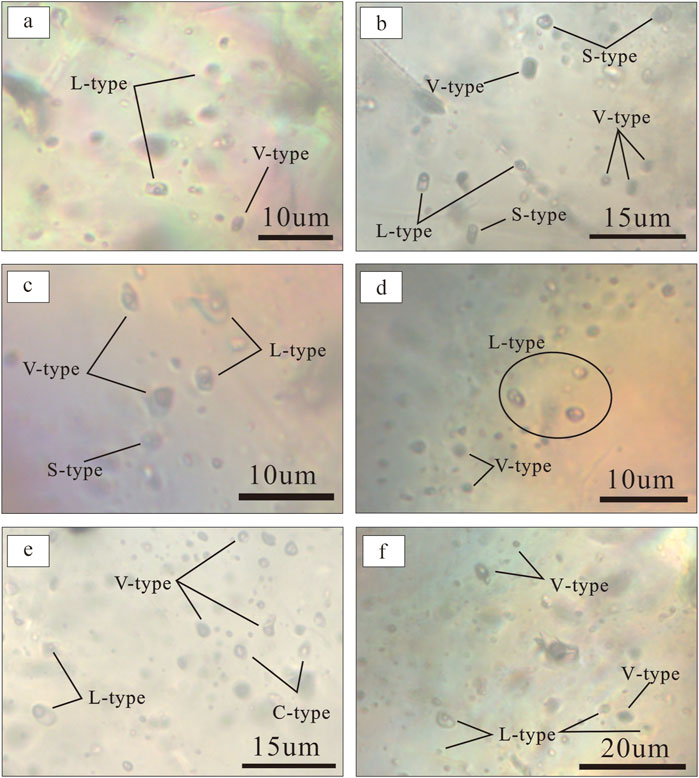
Figure 7. Photomicrographs of representative primary fluid inclusions in auriferous quartz from the middle (a–c) and western (d–f) sections of the Zhilingtou gold deposit.
For the middle section, 210 FIs measurements from ore-stage quartz were performed (Table 2; Figures 7a–c). In stage I, L-type inclusions homogenized into liquid completely at 273°C–352°C (avg. 314°C), ice melting temperatures are −3.2 to −2.1°C, corresponding to salinities of 3.53–5.09 wt.% NaCl eqv (avg. 4.54 wt.% NaCl eqv). V-type inclusions homogenized into gas completely at 293°C–367°C (avg. 330°C), ice melting temperatures are −2.6 to −1.8°C, corresponding to 3.05 to 4.32 wt.% NaCl eqv (avg. 3.84 wt.% NaCl eqv). S-type inclusions have their daughter minerals melted into liquid when heated to 295.3°C–376.8°C, homogenized into liquid completely at 300°C–376°C (avg. 346°C), corresponding to salinities of 37.78–44.92 wt.% NaCl eqv (avg. 40.59 wt.% NaCl eqv). In Stage II, L-type inclusions homogenized into liquid completely at 273°C–326°C (avg. 304°C), ice melting temperatures are −4.6 to −3.2°C, corresponding to 5.25 to 7.30 wt.% NaCl eqv (avg. 6.17 wt.% NaCl eqv). V-type inclusions homogenized into gas completely at 262°C–319°C (avg. 294°C), ice melting temperatures are −2.8 to −2.1°C, corresponding to 3.53 to 4.63 wt.% NaCl eqv (avg. 4.08 wt.% NaCl eqv). C-type inclusions homogenized at 276°C–328°C (avg. 304°C); solid CO2 melted at approximately −58°C, and CO2 clathrates melted at < 10°C, corresponding to salinities of 2.22–5.05 wt.% NaCl eqv (avg. 3.93 wt.% NaCl eqv). S-type inclusions have their daughter minerals melted into liquid when heated to 264.2°C–338.2°C, and homogenized into liquid completely at 298°C–338°C (avg. 314°C), corresponding to salinities of 35.57–41.31 wt.% NaCl eqv (avg. 38.17 wt.% NaCl eqv). In Stage III, L-type inclusions homogenized into liquid completely at 234°C–263°C (avg. 249°C), ice melting temperatures are −1.3 to −0.8°C, corresponding to salinities of 1.39–2.23 wt.% NaCl eqv (avg. 1.82 wt.% NaCl eqv). V-type inclusions homogenized into gas completely at 248°C–280°C (avg. 262°C), and ice melting temperatures are −2.5 to −1.6°C, corresponding to salinities of 2.73–4.17 wt.% NaCl eqv (avg. 3.47 wt.% NaCl eqv).
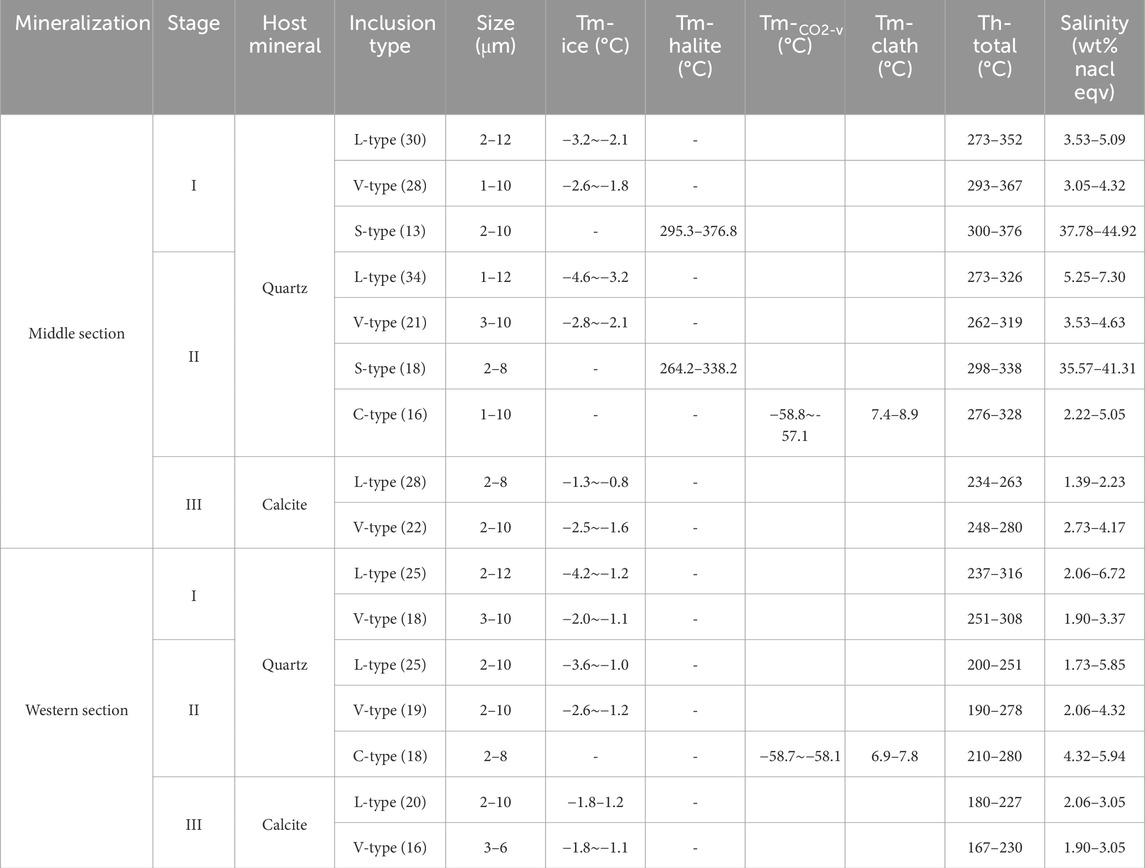
Table 2. Microthermometric data of fluid inclusions from hydrothermal quartz in the Zhilingtou deposit.
For the western section, we obtained temperature and salinity data on 141 inclusions in the three ore-stage quartz (Table 2; Figures 7d–f). In Stage I, the L-type inclusions homogenized into liquid completely at 237°C–316°C (avg. 271°C), and ice melting temperatures are −4.2 to −1.2°C, corresponding to salinities of 2.06–6.72 wt.% NaCl eqv (avg. 4.75 wt.% NaCl eqv). V-type inclusions homogenized into gas completely at 251°C–308°C (avg. 279°C), and ice melting temperatures are −2.0 to −1.1°C, corresponding to salinities of 1.90–3.37 wt.% NaCl eqv (avg. 2.75 wt.% NaCl eqv). In Stage II, L-type inclusions homogenized into liquid completely at 200°C–251°C (avg. 222°C), and ice melting temperatures are −3.6 to −1.0°C, corresponding to salinities of 1.73–5.85 wt.% NaCl eqv (avg. 4.35 wt.% NaCl eqv). V-type inclusions homogenized into gas completely at 190°C–278°C (avg. 232°C), and ice melting temperatures are −2.6 to −1.2°C, corresponding to salinities of 2.06–4.32 wt.% NaCl eqv (avg. 3.28 wt.% NaCl eqv). C-type inclusions homogenized at 210°C–280°C (avg. 244°C), solid CO2 melted at approximately −58°C, and CO2 clathrates melted at < 8°C, corresponding to salinities of 4.32–5.94 wt.% NaCl eqv (avg. 5.27 wt.% NaCl eqv). In Stage III, L-type inclusions homogenized into liquid completely at 180°C–227°C (avg. 201°C), and ice melting temperatures are −1.8 to −1.2°C, corresponding to salinities of 2.06–3.05 wt.% NaCl eqv (avg. 2.63 wt.% NaCl eqv). V-type inclusions homogenized into gas completely at 190°C–278°C (avg. 202°C), and ice melting temperatures are −1.8 to −1.1°C, corresponding to salinities of 1.90–3.05 wt.% NaCl eqv (avg. 2.52 wt.% NaCl eqv).
6.3 H‒O stable isotopes
In this study, hydrogen‒oxygen isotope analysis of FIs was conducted on single quartz minerals from the III-1 orebody in the middle section and the V-1 orebody in the western section, far from volcanic structures. The results are summarized in Table 3. The fluid δ18OH2O-SMOW values were calculated based on the homogenization temperatures of the FIs and the mineral-water oxygen isotope equation in the section on fluid inclusion microthermometry. The oxygen isotope equilibrium equation between quartz and water, as proposed by Clayton et al. (1972), is used: 103lnαquartz-water = 3.38 × 106/T2 - 3.40. Since the homogenization temperature of FIs is typically lower than the accurate mineralization temperature, the maximum homogenization temperature of the inclusions is used as an approximation for calculating the temperature (T value).
For the middle section of gold mineralization, the δDV-SMOW values from Stage I to Stage III are −81∼-68‰, −80∼-62‰, and −60∼-57‰, respectively, and the δ18OH2O-SMOW values are 2.6–5.0‰, −0.7–1.5‰, and −1.8∼-1.2‰, respectively. For the western section, the δDV-SMOW values from Stage I to Stage III are −82∼-74‰, −81∼-65‰, and −79∼-61‰, respectively, and the δ18OH2O-SMOW values are −0.5–1‰, −3.1∼-2.4‰, and −9.2∼-7.3‰, respectively.
6.4 S‒Pb isotopes
The δ34SCDT values for the middle section range from 3.30‰ to 7.67‰ (average of 6.39‰), whereas the δ34SCDT values for the western section range from 3.16‰ to 6.26‰ (average of 4.89‰). The overall δ34SCDT values are positive and follow a symmetric distribution pattern (Table 4; Figure 8).
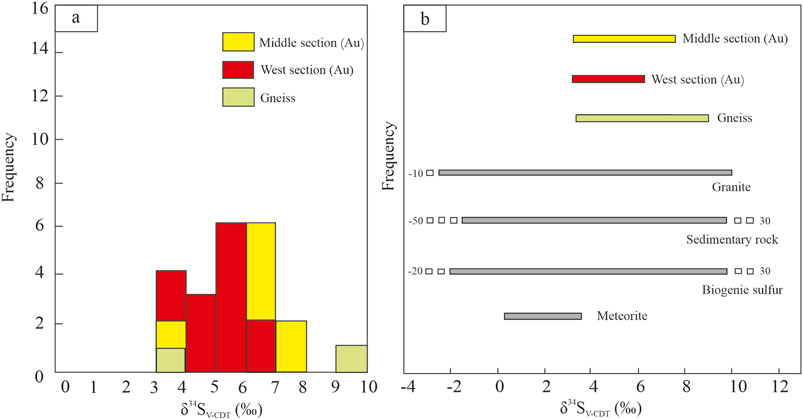
Figure 8. δ34S values for sulfide minerals (a) and comparison with other geological units (b) within the Zhilingtou gold deposit (b, modified after Hoefs, 2009).
Table 5 lists the in situ Pb isotope results. Nine gold ore samples were analyzed, with the following isotope ratios: 206Pb/204Pb ranging from 17.560 to 18.075, 207Pb/204Pb ranging from 15.639 to 15.686, and 208Pb/204Pb ranging from 38.832 to 40.105. These results are similar to those for gneiss in the Zhilingtou area (Table 5; Chu et al., 2020).
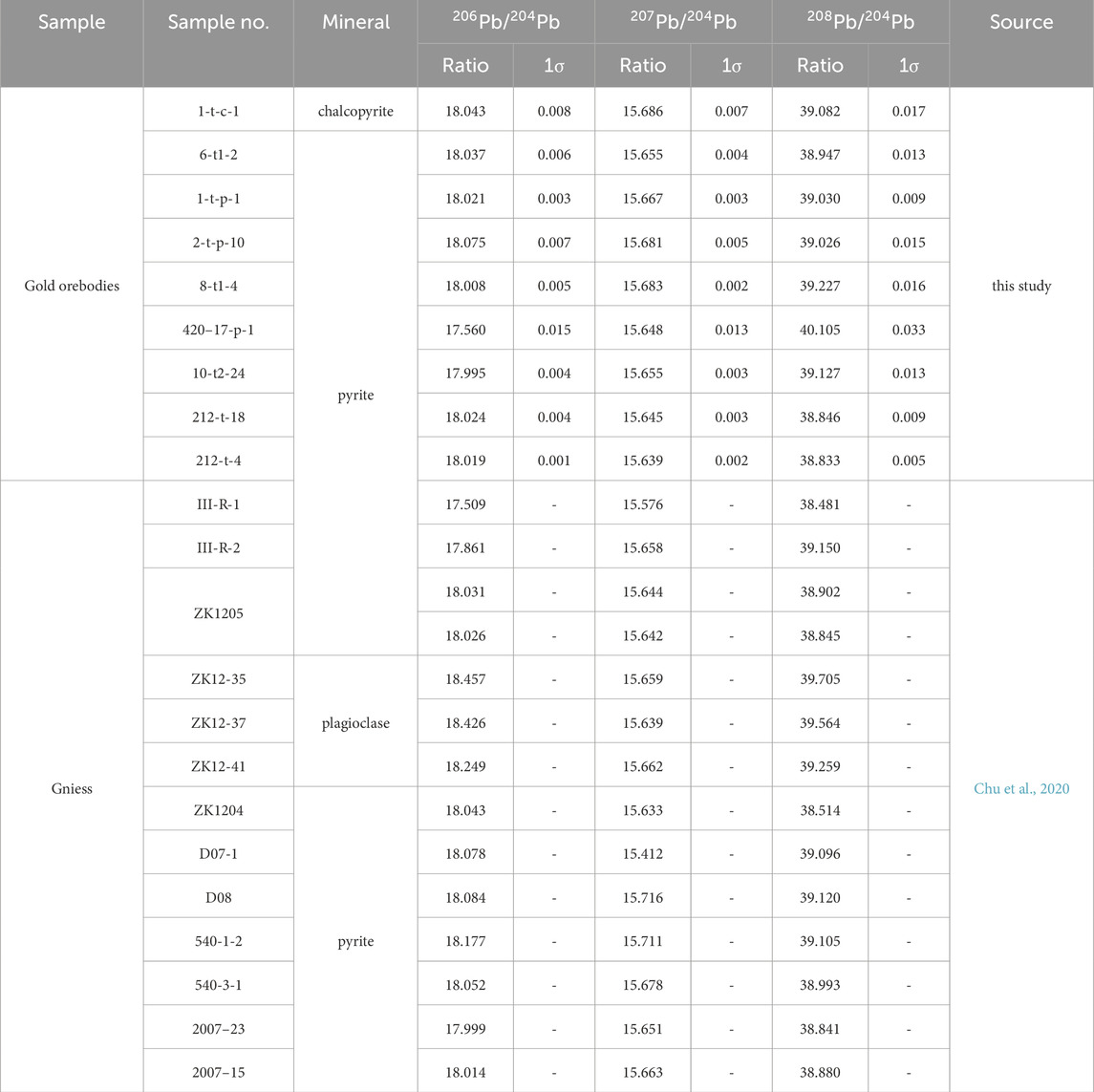
Table 5. Pb isotopic compositions of granitic feldspar and sulfide from the Zhilingtou gold deposit.
6.5 Gold content analysis
The geological units distributed within the Zhilingtou area primarily include Paleoproterozoic Badu Group gneiss, Triassic biotite monzogranite and K-feldspar granite, Cretaceous volcanic rocks and granite porphyry. These lithologies collectively control the formation and distribution of gold orebodies in the Zhilingtou area. This study analyzed the gold content in several geological units and ores from the Zhilingtou area via fire assay methods, yielding the following results (Table 6). In the V-1 gold orebody, the gold content exceeded the detection limit. The Triassic biotite granodiorite (230 ± 1 Ma, Liu et al., 2025a) and the Badu Group gneiss also have measurable gold contents (>0.001 μg/g), suggesting a possible association with gold mineralization. By contrast, other geological units, such as k-feldspar granite, granite porphyry, and tuff, presented gold contents below the detection limit.
7 Discussion
7.1 Nature and evolution of the ore-forming fluids
The fluid inclusion petrographic characteristics and the variations in temperature and salinity between the two sections of the Zhilingtou gold deposit reflect the changes in and evolutionary processes of the ore-forming fluid from Stage I to Stage III. The prominent characteristics of FIs in quartz veins from different ore-forming stages in the western section are the close relationships among L-, V-, and C-type inclusions, with S-type inclusions being rare or occasionally observed. By contrast, S-type inclusions are relatively well developed in the middle section. Considering the locations of the two sections, the types of inclusions and their homogenization temperatures, and previous studies on Yanshanian molybdenum mineralization near the middle section, the development of many S-type inclusions was identified as a fluid boiling system (Wang, 2014). We believe that Yanshanian hydrothermal activity had a strong superimposed and modifying effect on the gold mineralization of the middle section, whereas its impact on the western section was relatively minor. As the fluid evolves from Stage I to Stage II, the number of S-type inclusions decreases, and they no longer develop in Stage III. Additionally, the abundance of V-type inclusions also decreases. The homogenization temperature and salinity of inclusions of the same type gradually decrease over time (Figure 9). These changes suggest that the fluid evolved from medium to high temperatures (237°C–316°C) and low salinities (1.90–6.72 wt.% NaCl eqv) in Stage I to a medium-to low-temperature (167°C–230°C), low-salinity (1.90–3.05 wt.% NaCl eqv) state in Stage III.
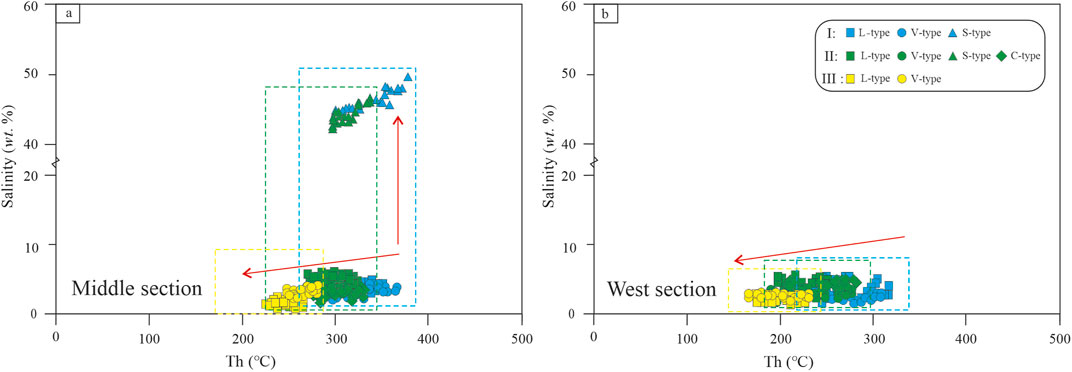
Figure 9. Summary plot of homogenization temperatures and salinities of individual fluid inclusions from different stages of the middle section (a) and the west section (b) within the Zhilingtou area. Abbreviations: L-type, liquid-rich inclusions; V-type, gas-rich inclusions; S-type, three-phase FIs containing daughter minerals; C-type, CO2-bearing two-phase/three-phase inclusions.
This evolution reflects the transition of the initial fluid, which was related to magmatic activity, as it mixed with meteoric water and underwent water‒rock interactions with surrounding rocks during its ascent toward the surface, ultimately leading to mineral precipitation. Geographically, the middle section of the gold deposit is closer to the Huafengjian volcanic edifice, making it more susceptible to the effects of Yanshanian volcanic activity. This interpretation is further supported by the presence of S-type inclusions in the auriferous quartz veins of the middle section, which are absent in the western section.
7.2 Source of the ore-forming fluids
In the δ18OH2O-SMOW vs. δDV-SMOW diagram, a distinct trend is observed from the early to late stages of mineralization in both the middle and western sections (Figure 10). The data for Stages I and II plot closer to the magmatic water range, whereas the data for Stage III are generally closer to the meteoric water range. This suggests that from Stage I to Stage III, the source of the fluid gradually migrated toward meteoric water. This trend implies that the ore-forming fluid consisted initially of magmatic water, which then progressively mixed with meteoric water. This process is recorded by the changes of H–O isotope composition (Wu and Li, 2016).
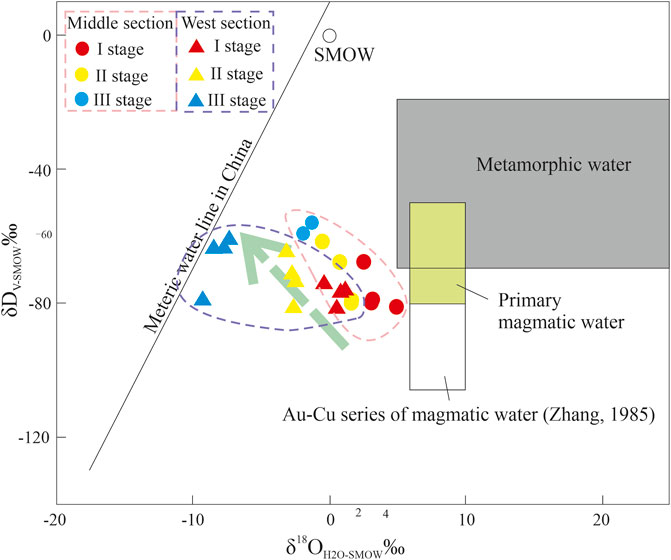
Figure 10. δ18O–δD diagram (after Taylor, 1974) for the ore fluids from the Zhilingtou gold deposit. The field of the Au–Cu magmatic water series is from Zhang (1985).
7.3 Source of ore-forming materials
7.3.1 Sulfur isotopes
Sulfur isotopes have been extensively used to trace the source of ore-forming materials. However, the preparation of single mineral sulfide samples is susceptible to contamination from multiple generations and stages of sulfides, which can result in the mixing of sulfur isotopes from different sulfide stages, leading to significant distortion of the data. In this study, sulfur isotope analysis was conducted on pyrite from each stage of gold mineralization, with a total of 30 samples analyzed (Table 4). No sulfate minerals were observed in the main ore-forming stage of gold mineralization, and the sulfur isotopic compositions exhibited a relatively narrow range. This suggests that the ore-forming process occurred under conditions of low oxygen fugacity, during which the sulfur in the fluid predominantly existed in the form of HS− and S2-. Pyrite, as the main sulfur-bearing mineral, can be considered to approximate the overall δ34SΣ value of a fluid (Ohmoto, 1972; Wang et al., 2023).
The δ34SCDT values of the gold orebodies typically overlap with the sulfur isotope range observed in ore deposits related to magmatism (approximately −10‰ to 10‰; Kerrich, 1987, Kerrich, 1989; Partington and Williams, 2000), which contrasts with the sulfur values derived from a single, homogeneous magmatic source (ranging from −3 to 1‰, Hoefs, 2009; mantle-derived sulfur: ±0‰) or from marine or seawater sulfur (approximately 20‰; Ohmoto, 1972; Seal, 2006), exhibiting there is a certain degree of external sulfur input during the mineralization process. Additionally, the sulfur isotope range of the gneiss from the Paleoproterozoic Badu Group (3.34‰–9.08‰) overlaps with the δ34SCDT values observed in the gold orebodies, suggesting a close relationship between gold mineralization and the Paleoproterozoic Badu Group (Figure 8). Furthermore, in combination with previous findings, it is inferred that during stages II and III of ore formation, meteoric water likely mixed with hydrothermal fluid and reacted with the surrounding gneiss, introducing new δ34SCDT values into the ore-forming system.
7.3.2 Lead isotopes
The in situ Pb isotope analysis of pyrite and chalcopyrite from the gold sections is shown in Figure 11 and Table 5. In the 206Pb/204Pb vs. 207Pb/204Pb diagram (Figure 11a), the values are relatively uniform except for some apparent outliers. The values and previous data are distributed on both sides of the upper crust evolution line, indicating characteristics consistent with a crustal source for mineralization. In the 206Pb/204Pb vs. 208Pb/204Pb diagram (Figure 11b), all the data plot within the lower crust and orogenic belt fields and plot closer to the lower crust evolution line, reflecting a crustal source.
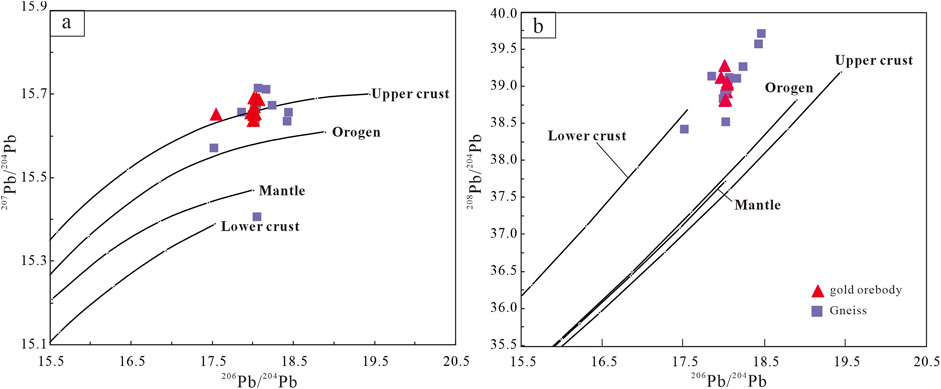
Figure 11. Lead isotopic compositions of the Zhilingtou gold deposit. (a) 206Pb/204Pb vs. 207Pb/204Pb diagram, (b) 206Pb/204Pb vs. 208Pb/204Pb diagram. Mantle, orogen, upper crust and lower crust are modified after Zartman and Doe. (1981).
7.4 Genetic classification
The genesis of the Zhilingtou gold deposit has been the subject of ongoing debate since its discovery, with several critical hypotheses proposed regarding its formation. One perspective links it to a Proterozoic orogenic gold system (Ni et al., 2012), whereas another attributes its formation to an early Cretaceous mineralization event involving molybdenum, lead–zinc, and hydrothermal gold (Wang, 2014; Wang et al., 2020). Additionally, early metamorphism of sedimentary rocks is thought to have contributed to gold enrichment, which was further enhanced by volcanic and hydrothermal activity in the Badu Group (Xu et al., 1987; Zhang et al., 1991).
In this study, we conclude that the Zhilingtou gold orebodies are predominantly distributed along WNW- to nearly E-W-trending faults. These faults are intersected by N–S-oriented F1 and F42 faults. However, the orebodies are exclusively hosted within the Proterozoic Badu Group biotite plagioclase gneiss and concealed beneath the volcanic rocks. The metaluminous to peraluminous biotite monzogranite (230 ± 1 Ma, Liu et al., 2025b), coeval with gold mineralization (230 ± 2 Ma, Liu et al., 2025a), is present within the mining area and serves as the ore-forming rock for the gold deposit. Furthermore, a spatial relationship and similar hydrothermal alteration types exist between the orebodies and the biotite monzogranite (Liu et al., 2025b). Fluid inclusion analyses and H-O-S isotopic compositions show that the ore-forming fluid is derived from a magmatic source and exhibits multiple stages of evolution. With the continuous mixing of meteoric water and the decrease in temperature and pressure, the ore-forming fluid continuously reacted with the country rock through hydrothermal alteration, and the ore-forming hydrothermal fluid showed evident external sulfur input. The tectonic discrimination diagrams based on Pb isotopes show that the lead in the Zhilingtou gold deposit mainly derived from the crust, which is consistent with the characteristics of the biotite monzogranite that originated mainly from the partial melting of late Paleoproterozoic basement in the lower crust (Liu et al., 2025b). In addition, all the samples from previous studies (Chu et al., 2020) and our study define a linear trend between the Cathaysia metamorphic basement and gold orebody curves (Figure 11), suggesting that both the biotite monzogranite and metamorphic basement contributed ore-forming materials for the gold mineralization at Zhilingtou. The measured gold contents reveal the genetic relationships among the gneisses of the Badu Group, biotite monzogranite and gold mineralization. Zheng and Liu (1986) have shown that the gold contents of gneisses near gold orebodies have significantly decreased (average = 4.77 ppb). The unaltered gneisses, which are far from mineralization, have higher gold contents (average = 11.9 ppb, Zheng and Liu, 1986). This finding also indicates that the surrounding gneisses play an important role in the accumulation and precipitation of gold mineralization. The influx of magma further extracts and activates some of the ore-forming elements in the gneiss and carries them away. However, the gold mineralization differs from low-sulfidation epithermal gold deposits in many geological and geochemical characteristics, such as the lack of typical adularia–sericite alteration (Heald et al., 1987), the metal suite of Au–Te–Bi–As–Sb, and the close association with dioritic dikes. Instead, these characteristics are very similar to those of epizonal IRGDs, as described by Lang et al. (2000), Baker (2002), and Hart (2005). Therefore, the Zhilingtou gold deposit is speculated to be an IRGD formed in the Triassic. The ore-forming fluid, carrying gold and other ore-forming elements, experiences a gradual decrease in temperature and pressure during its ascent. As it mixes with meteoric water, it continuously reacts with the surrounding gneiss, mobilizing and activating some of the gold elements and transporting them to fault zones, where the orebodies ultimately form (Figure 12).
7.5 Tectonic setting
Discussions regarding the formation mechanisms and tectonic setting of the South China’s Triassic magmatic–hydrothermal processes have been diverse (Pirajno and Bagas, 2002; Sun et al., 2010; Zhou et al., 2006; Zhou and Li, 2000; Mao et al., 2008), including an intracontinental collision orogeny (Zhou et al., 2006; Wang et al., 2013) and a Paleo-Pacific plate subduction model (Li et al., 2006; Li and Li, 2007). An increasing consensus among scholars suggests that the extensive granites and associated polymetallic mineralization during the Yanshanian period were closely linked to the subduction of the Paleo-Pacific plate beneath the Eurasian plate (Zhou et al., 2006; Mao et al., 2006; Mao et al., 2007; Mao et al., 2010; Mao et al., 2013; Li and Li, 2007; Sun et al., 2010). Early Indosinian north‒south compression and early Yanshanian east‒west compression mark the transition from the Tethyan tectonic domain, which is predominantly characterized by east‒west structures, to the early Yanshanian Pacific margin tectonic domain, which is dominated by NNE-oriented structures (Zhang et al., 2009). Following a period of relatively subdued tectonic-magmatic activity between approximately 205 and 180 Ma (Zhou et al., 2006), the prevailing tectonic regime shifted toward the Pacific tectonic domain. This transformation was likely the result of oblique subduction of the Izanagi plate at the ancient Pacific margin (Maruyama et al., 1997). The northwestward migration of the Izanagi plate toward the Eurasian continent is believed to have triggered intense tectonic activity beginning at approximately 175 Ma (Maruyama and Send, 1986; Moore, 1989; Wan, 1993; Mao et al., 2007; 2008; 2011). Recently, Mao et al. (2021) identified a middle-late Jurassic magmatic–hydrothermal copper mineralization belt along the southeastern coast of China, with an age range of 171–153 Ma, extending approximately 2,000 km in a northeastward direction. This mineralization event coincided with the Sn–W mineralization event in the Lingnan region (165–150 Ma), which occurred in a back-arc extensional setting, thus reflecting a typical subduction-related ore-forming model. Similar views have been proposed by Wang et al. (2012), Wang et al. (2015) and Zhang et al. (2020), Zhang et al. (2022), who suggested that the copper deposits in the Qin-Hang belt of South China formed in an intracontinental extensional environment induced by far-field stress from the subduction of the ancient Pacific plate at approximately 170–160 Ma. This evidence strongly supports the occurrence of a subduction event along the East Asian continental margin during the Jurassic period in South China, bearing significant similarities to the ore-forming evolution observed in the middle segment of the Andes during the Cenozoic.
By contrast, the intracontinental collision orogeny has gained recognition from many scholars (Guo et al., 1983; Ren, 1984; Hsü et al., 1990; Guo, 1992; Xie et al., 1999; Wang et al., 2001; Zhou et al., 2006; Zhang et al., 2009; Bai et al., 2012; Zhou et al., 2015). Wang et al. (2001) linked Triassic granites with the collision of North China and South China blocks. Zhou et al. (2006) identified 257 Ma postcollisional granites in the Shilu and Bangxi areas of Hainan and 255 Ma synorogenic granites in the Lelai area of Qiongdong (Xie et al., 1999), indicating that the collision likely occurred in the early Triassic, coinciding with the timing of the Songma suture zone formation. Zhang et al. (2009) suggested that South China’s E-W-trending fold belts during the Indosinian period were closely related to the collision between the southern and northern source blocks of the South China continental margin. The late Triassic, corresponding to a postcollisional setting, experienced tectonic deformation and magmatic activity against a tectonic background shaped by the convergence of multiple plates, including South China, North China, Indochina, and the paleo-Pacific plate (Wang et al., 2013; Gao et al., 2017), resulting in a series of late Triassic low-temperature gold and lead–zinc deposits west of South China’s Yangtze Block (Hu et al., 2017). The postcollisional intracontinental extension during the Indosinian orogeny, controlled by the continuation of Tethyan tectonic movements, led to the formation of an intraplate rift system in the South Lingnan volcanic-intrusive belt, which is composed of basic-ultrabasic rocks, bimodal volcanic rocks, and A-type granites (200–180 Ma).
Overall, we believe that the Zhilingtou gold deposit formed in a tectonic environment characterized by postcompression extension. The mineralized hydrothermal fluids provided the necessary ingredients for gold mineralization. The water‒rock reactions between the strata and the hydrothermal fluids created conditions for the activation and enrichment of gold. The faults provided pathways and spaces for fluid migration and mineral precipitation and controlled the distribution of the gold ore bodies.
8 Conclusion
1. The mineralization of the Zhilingtou gold deposit can be classified into three distinct stages: (i) pyrite-quartz, (ii) polymetallic sulfide-quartz, and (iii) quartz-calcite. Gold is largely enriched and precipitated during Stage II.
2. Fluid inclusion analysis and H–O isotopes indicate that gold mineralization occurred within a medium–high temperatures (237°C–316°C) and low salinities (1.90–6.72 wt.% NaCl eqv) NaCl–H2O–CO2 hydrothermal system. Initially, the mineralizing fluid was magmatic in origin, but it continuously mixed with meteoric water over time.
3. Sulfur and lead isotopes suggest that gold mineralization is closely related to magmatic activity, and the Proterozoic gneiss also made a certain contribution to its formation. Some of the gold may have originated from leaching or exchange processes between hydrothermal fluids and adjacent gneisses.
4. The Zhilingtou gold deposit is an intrusion-related gold deposit formed in the Triassic period, which was in an extensional tectonic environment following the collision of the Indosinian, South China, and North China blocks.
Data availability statement
The original contributions presented in the study are included in the article/Supplementary Material, further inquiries can be directed to the corresponding author.
Author contributions
HL: Formal Analysis, Methodology, Writing – original draft, Data curation, Investigation. XY: Project administration, Supervision, Writing – review and editing. SD: Data curation, Methodology, Writing – review and editing. YS: Data curation, Methodology, Writing – review and editing. YW: Data curation, Writing – review and editing. JM: Project administration, Supervision, Writing – review and editing.
Funding
The author(s) declare that financial support was received for the research and/or publication of this article. This research was financially supported jointly by the project of the China Geological Survey [DD20230349] and the MOST Special Fund from the state Key Laboratory of Geological Processes and Mineral Resources, China University of Geosciences [GPMR202438].
Conflict of interest
The authors declare that the research was conducted in the absence of any commercial or financial relationships that could be construed as a potential conflict of interest.
Generative AI statement
The author(s) declare that no Generative AI was used in the creation of this manuscript.
Publisher’s note
All claims expressed in this article are solely those of the authors and do not necessarily represent those of their affiliated organizations, or those of the publisher, the editors and the reviewers. Any product that may be evaluated in this article, or claim that may be made by its manufacturer, is not guaranteed or endorsed by the publisher.
References
Bai, D. Y., Jia, B. H., Zhong, X., Liu, Y. R., Jia, P. Y., and Huang, W. Y. (2012). Study on the deformation of indosinian movement in southeastern hunan. Geol. Rev. 58 (01), 19–29. doi:10.16509/j.georeview.2012.01.012 (in Chinese with English abstract).
Baker, T. (2002). Emplacement depth and carbon dioxide-rich fluid inclusions in intrusion-related gold deposits. Econ. Geol. 97, 1111–1117. doi:10.2113/97.5.1111
Bodnar, R. J. (1993). Revised equation and table for determining the freezing point depression of H2O–NaCl solutions. Geochim. Cosmochim. Acta 57, 683–684. doi:10.1016/0016-7037(93)90378-a
Bodnar, R. J. (1994). Interpretation of microthermometric data for H2O–NaCl fluid inclusions. Short Course Work. Group B Inclusion Minerals.
Brown, P. E., and Hagemann, S. G. (1995). Macflincor and its application to fluids in archean lode–gold deposits. Geochim. Cosmochim. Acta 59 (19), 3943–3952. doi:10.1016/0016-7037(95)00254-w
Bureau of Geology and Mineral Resources of Zhejiang Province. (1989). Regional geology of Zhejiang province. Geological publishing house, Beijing (in Chinese).
Cai, W. Y., Song, M. C. M. S. L., Santosh, M., and Li, J. (2024). The gold-telluride connection: evidence for multiple fluid pulses in the Jinqingding telluride-rich gold deposit of Jiaodong Peninsula, Eastern China. Geosci. Front. 15, 101795. doi:10.1016/j.gsf.2024.101795
Cai, W. Y., Wang, K. Y., Li, J., Fu, L. J., Lai, C. K., and Liu, H. L. (2021). Geology, geochronology and geochemistry of large Duobaoshan Cu-Mo-Au orefield in NE China: magma genesis and regional tectonic implications. Geosci. Front. 12, 265–292. doi:10.1016/j.gsf.2020.04.013
Cameron, E. M., and Hattori, K. (1987). Archean gold mineralization and oxidized hydrothermal fluids. Econ. Geol. 82, 1177–1191. doi:10.2113/gsecongeo.82.5.1177
Chen, J. F., and Jahn, B. M. (1998). Crustal evolution of southeastern China: Nd and Sr isotopic evidence. Tectonophysics 1284, 101–133. doi:10.1016/s0040-1951(97)00186-8
Chi, G. X., and Lu, H. Z. (2008). Validation and representation of fluid inclusion microthermometric data using the fluid inclusion assemblage (FIA) concept. Acta Petrol. Sin. 24 (9), 1945–1953. doi:10.1134/S0869593808050109
Chu, K. L., Chen, X. R., Qi, G., Gao, X., Hu, B., and Li, S. J. (2020). Sulfur and lead isotope tracing for sources of ore-forming material and ore-forming age of the Zhilingtou Mo-Pb-Zn-Au polymetallic deposit in the Zhejiang Province. Acta Geol. Sin. 94(8), 2325–2340. doi:10.19762/j.cnki.dizhixuebao.2020034
Clayton, R. N., and Mayeda, T. K. (1963). The use of bromine pentafluoride in the extraction of oxygen from oxides and silicates for isotopic analysis. Geochim. Cosmochim. Acta 27, 43–52. doi:10.1016/0016-7037(63)90071-1
Clayton, R. N., O'Neil, J. R., and Mayeda, T. K. (1972). Oxygen isotope exchange between quartz and water. J. Geophsic Res. 77, 3057–3067. doi:10.1029/JB077i017p03057
Deng, J. F., Zhao, H. L., Mo, X. X., Liu, H. X., and Luo, Z. H. (1995). Intracontinental subduction of the Yangtze continent and continent reducing-inferred from muscovite (two mica) granites. J. Geol. Univ. 1 (1), 50–57.
Friedman, I. (1953). Deuterium content of natural waters and other substances. Geochim. Cosmochim. Acta 4, 89–103. doi:10.1016/0016-7037(53)90066-0
Gao, P., Zhang, Y. F., and Zhao, Z. F. (2017). Triassic granites in South China: a geochemical perspective on their characteris–tics, petrogenesis, and tectonic significance. Earth–Science Rev. 173, 266–294. doi:10.1016/j.earscirev.2017.07.016
Goldfarb, R. J., Baker, T., Dube, B., Groves, D. I., Hart, C. J. R., and Gosselin, P. (2005). Distribution, character and genesis of gold deposits in metamorphic terranes. Econ. Geol. 100th Anniv., 407–450. doi:10.5382/AV100.14
Goldfarb, R. J., Groves, D. I., and Gardoll, S. (2001). Orogenic gold and geologic time: a global synthesis. Ore Geol. Rev. 18, 1–75. doi:10.1016/s0169-1368(01)00016-6
Groves, D. I., Santosh, M., Deng, J., Wang, Q., Yang, L., and Zhang, L. (2020). A holistic model for the origin of orogenic gold deposits and its implications for exploration. Min. Deposita 55, 275–292. doi:10.1007/s00126-019-00877-5
Guo, F., Fan, W. M., Li, C. W., Zhao, L., Li, H. X., and Yang, J. H. (2012). Multi-stage crust–mantle interaction in SE China: temporal, thermal and compositional constraints from the Mesozoic felsic volcanic rocks in eastern Guangdong–Fujian provinces. Lithos 150, 62–84. doi:10.1016/j.lithos.2011.12.009
Guo, F. X. (1992). On the nature of the “indosinian movement” of South China. Yunnan Geol. 02, 169–180.
Guo, L. Z., Shi, Y. S., and Ma, R. S. (1983). Formation and evolution of the cenozoic active continental margins and island arc tectonics in the western pacific. Acta Geol. Sin. 01, 11–21. doi:10.19762/j.cnki.dizhixuebao.1983.01.002 (in Chinese).
Hart, C. J. R. (2005). Classifying, distinguishing and exploring for intrusion-related gold systems. Gangue 87, 1–9.
Hart, C. J. R., Goldfarb, R. J., Lewis, L. L., and Mair, J. L. (2004). The northern cordilleran mid-cretaceous plutonic province: ilmenite/magnetite-series granitoids and intrusion-related mineralisation. Resour. Geol. 54, 253–280. doi:10.1111/j.1751-3928.2004.tb00206.x
He, Z. Y., and Xu, X. S. (2012). Petrogenesis of the Late Yanshanian mantle–derived intrusions in southeastern China: response to the geodynamics of paleo–Pacific plate subduction. Chem. Geol. 328, 208–221. doi:10.1016/j.chemgeo.2011.09.014
Heald, P., Fbley, N. K., and Hayba, D. O. (1987). Comparative anatomy of volcanic-hosted epithermal deposits: acide-sulfate and adularia-hosted type. Econ. Geol. 82, 1–23. doi:10.2113/gsecongeo.82.1.1
Hsü, K. J., Li, J. L., Chen, H. H., Wang, Q. C., Sun, S., and Sengor, A. M. C. (1990). Tectonics of South China: key to understanding west Pacific geology. Tectonophysics 183, 9–39. doi:10.1016/0040-1951(90)90186-c
Hu, R. Z., Chen, W. T., Xu, D. R., and Zhou, M. F. (2017). Reviews and new metallogenic models of mineral deposits in south China: an introduction. J. Asian Earth Sci. 137, 1–8. doi:10.1016/j.jseaes.2017.02.035
Hu, Z. C., Zhang, W., Liu, Y. S., Gao, S., Li, M., Zong, K. Q., et al. (2015). “Wave” signal-smoothing and mercury-removing device for laser ablation quadrupole and multiple collector ICPMS analysis: application to lead isotope analysis. Anal. Chem. 87 (2), 1152–1157. doi:10.1021/ac503749k
Hua, J. X., and Liu, H. L. (2022). Zircon U-Pb age, geochemical characteristics and formation setting of felsite in the Zhilingtou area, Zhejiang Province. Glob. Geol. 41, 26–37.
Hua, R. M. (2005). Differences between rock–forming and related ore–forming times for the mesozoic granitoids of crust remelting types in the nanling range, south China, and its geological significance. Geol. Rev. 06, 633–639. doi:10.16509/j.georeview.2005.06.006 (in Chinese with English abstract).
Jia, B. H. (1998). Preliminary study on the emplacement mechanism of granite plutons in Hunan. Hunan Geol. Supplemen. 10, 1–164.
Kerrich, R. (1987). “The stable isotope geochemistry of Au-Ag vein in deposits in metamorphic rocks,” in Stable isotope geochemistry of low temperature fluids. Editor T. K. Kyser (Mineral. Assoc. Canada, Short Course Handbook), 287–336.
Kerrich, R. (1989). “Geodynamic setting and hydraulic regimes: shear zone hosted mesothermal gold deposits,” in Mineralization and Shear Zones. Editor J. T. Bursnall (Geological Association of Canada Short Course) 6, 89–128.
Lang, J. R., Baker, T., Hart, C. J. R., and Mortensen, J. K. (2000). An exploration model for intrusion-related gold deposits: society of Economic Geologists Newsletter 40, 1, 6.
Lapierre, H., Jahn, B., Charvet, J., and Yu, Y. (1997). Mesozoic felsic arc magmatism and continental olivine tholeiites in Zhejiang Province and their relationship with the tectonic activity in southeastern China. Tectonophysics 274, 321–338. doi:10.1016/s0040-1951(97)00009-7
Li, B., Jiang, S. Y., Lu, A. H., Lai, J. Q., Zhao, K. D., and Yang, T. (2016). Petrogenesis of late jurassic granodiorites from gutian, fujian province, south China: implications for multiple magma sources and origin of porphyry Cu–Mo mineralization. Lithos 264, 540–554. doi:10.1016/j.lithos.2016.09.020
Li, J., Wang, K. Y., Cai, W. Y., Sun, F. Y., Liu, H. L., Fu, L. J., et al. (2020). Triassic gold-silver metallogenesis in Qingchengzi orefield, North China Craton: perspective from fluid inclusions, REE and H-O-S-Pb isotope systematics. Ore Geol. Rev. 121, 103567. doi:10.1016/j.oregeorev.2020.103567
Li, J., Yang, Z. M., Song, M. C., Dong, L. L., Li, S. Y., Wang, R. S., et al. (2023). Gold remobilization of the Sanshandao gold deposit, Jiaodong Peninsula, Eastern China: perspective from in-situ sulfide trace elements and sulfur isotopes. Ore Geol. Rev. 158, 105505. doi:10.1016/j.oregeorev.2023.105505
Li, X. H., Li, Z. X., Li, W. X., and Wang, Y. (2006). Initiation of the indosinian orogeny in South China: evidence for a permian magmatic arc on hainan island. J. Geol. 114 (3), 341–353. doi:10.1086/501222
Li, Z. X., and Li, X. H. (2007). Formation of the 1300-km-wide intracontinental orogen and postorogenic magmatic province in Mesozoic South China: a flat-slab subduction model. Geology 35, 179–182. doi:10.1130/g23193a.1
Li, Z. X., Li, X. H., Wartho, J. A., Clark, C., Li, W. X., Zhang, C. L., et al. (2010). Magmatic and metamorphic events during the early Paleozoic Wuyi–Yunkai orogeny, southeastern South China: new age constraints and pressure–temperature conditions. Geol. Soc. Am. Bull. 122, 772–793.
Liang, G. Z., Yang, K. F., Sun, W. Q., Fan, H. R., Li, X. H., Lan, T. G., et al. (2021). Multistage ore-forming processes and metal source recorded in texture and composition of pyrite from the Late Triassic Asiha gold deposit, Eastern Kunlun Orogenic Belt, western China. Asian Earth Sci. 220, 104920. doi:10.1016/j.jseaes.2021.104920
Liu, H. L., Mao, J. W., Duan, S. G., Yang, C. D., Bai, Y. L., and Zhang, T. Z. (2023). Geochronology, geochemistry, and Sr–Nd–Hf isotopes of the Cretaceous igneous rocks in the Zhilingtou area, SE China, and their geological significance. Ore Geol. Rev. 153, 105273. doi:10.1016/j.oregeorev.2022.105273
Liu, H. L., Mao, J. W., Duan, S. G., Yang, C. D., Zhang, Y., and Hua, J. X. (2025a). In situ U-Pb dating of hydrothermal rutile and monazite from the Zhilingtou lode gold deposit: evidence for the Triassic gold mineralization in the Cathaysia Block, South China. Miner. Deposita, under Rev.
Liu, H. L., Yu, X. F., Duan, S. G., Sun, Y. D., Wang, Y. C., and Mao, J. W. (2025b). Late indosinian extensional metallogenic events in South China: evidence from the triassic granites of the Zhilingtou gold deposit in Zhejiang province. Ore Geol. Rev. under Rev.
Liu, P., Mao, J. W., Santosh, M., Bao, Z. A., Zeng, X. J., and Jia, L. H. (2018). Geochronology and petrogenesis of the Early Cretaceous A–type granite from the Feie’Shan W–Sn deposit in the eastern Guangdong Province, SE China: implications for W–Sn mineralization and geodynamic setting. Lithos 300, 330–347. doi:10.1016/j.lithos.2017.12.015
Lu, H. Z., Fan, H. R., Ni, P., Ou, G. X., Shen, K., and Zhang, W. H. (2004). Fluid inclusion. Beijing: Science Press, 1–485. (in Chinese).
Mair, J. L., Farmer, G. L., Groves, D. I., Hart, C. J. R., and Goldfarb, R. J. (2011). Petrogenesis of postcollisional magmatism at Scheelite Dome, Yukon, Canada: evidence for a lithospheric mantle source for magmas associated with intrusion-related gold systems. Econ. Geol. 106, 451–480. doi:10.2113/econgeo.106.3.451
Mao, J. R., Chen, R., Li, J. Y., Ye, H. M., and Zhao, X. L. (2006). Geochronology and geochemical characteristics in Mesozoic granodioritic rocks in southwestern Fujian, and their tectonic evolution, 34. Earth Science Edition: Journal of Jilin University, 12–20.
Mao, J. W., Cheng, Y. B., Chen, M. H., and Pirajno, F. (2013). Major types and time–space distribution of Mesozoic ore deposits in South China and their geodynamic settings. Mineralium Deposita 48, 267–294.
Mao, J. W., Chen, M. H., Yuan, S. D., and Guo, C. L. (2011). Geological characteristics of the qinhang (or shihang) metallogenic belt in South China and spatial–temporal distribution regularity of mineral deposits. Acta Geol. Sin. 85 (05), 636–658.
Mao, J. W., Xie, G. Q., Guo, C. L., and Cheng, Y. C. (2007). Large–scale tungsten–tin mineralization in the Nanling region, South China: metallogenic ages and corresponding geodynamic processes. Acta Petrol. Sin. 23 (10), 2329–2338. doi:10.3969/j.issn.1000-0569.2007.10.002
Mao, J. W., Xie, G. Q., Guo, C. L., Yuan, S. D., Cheng, Y. B., and Chen, Y. C. (2008). Spatial–temporal distribution of Mesozoic ore deposits in South China and their metallogenic settings. Geol. J. China Univ. 14, 510–526.
Mao, J. W., Xie, G. Q., Pirajno, F., Ye, Y. B., Wang, Y. F., Lie, J. F., et al. (2010). Late jurassic–cretaceous granitoids in the eastern qinling, central–eastern China: SHRIMP zircon U–Pb ages and tectonic implications. Australia journal of earth Sciences, (1), 51–78.
Mao, J. W., Zheng, W., Xie, G. Q., Lehmann, B., and Goldfarb, R. (2021). Recognition of a Middle–Late Jurassic arc-related porphyry copper belt along the southeast China coast: geological characteristics and metallogenic implications. v 49, 592–596. doi:10.1130/g48615.1
Maruyama, S., Isozaki, Y., Kimura, G., and Terabayashi, M. (1997). Paleogeographic maps of the Japanese Islands: plate tectonic synthesis from 750 Ma to the present. Isl. Arc 6, 121–142. doi:10.1111/j.1440-1738.1997.tb00043.x
Maruyama, S., and Send, T. (1986). Orogeny and relative plate motion: example of the Japanese Islands. Tectonophysics 127, 305–329. doi:10.1016/0040-1951(86)90067-3
Mernagh, T. P., Bastrakov, E. N., Zaw, K., Wygralak, A. S., and Wyborn, L. A. I. (2007). Comparison of fluid inclusion data and mineralization processes for Australian orgenic gold and intrusion-related gold systems. Acta Petrol. Sin. 23 (01), 21–32. doi:10.3321/j.issn:1000-0569.2007.01.004
Moore, G. W. (1989). Mesozoic and Cenozoic paleographic development of the Pacific region. 28th Int. Geol. Congr. 28, 455–456. doi:10.1007/978-1-4613-2351-8_2
Ni, P., Tian, J. H., Zhu, X. T., Ling, H. F., Jiang, S. Y., and Gu, L. X. (2005). Fluid inclusion studies on footwall stringer syetem mineralization of Yongping massive copper deposit, Jiangsu province, China. Acta Petrol. Sin. 21, 1339–1346. doi:10.3969/j.issn.1000-0569.2005.05.003 (in Chinese with English abstract)
Ni, P., Zhao, C., Wang, G. G., and Liu, J. R. (2012). Ore genesis of the Zhilingtou gold deposit, lishui, Zhejiang province. Nanjing: School of Earth Sciences and Engineering, 354.
Ohmoto, H. (1972). Systematics of sulfur and carbon isotopes in hydrothermal ore deposits. Econ. Geol. 67, 551–578. doi:10.2113/gsecongeo.67.5.551
Ouyang, H. G., Wu, X. L., Mao, J. W., Su, H. M., Santosh, M., Zhou, Z., et al. (2014). The nature and timing of ore formation in the Budunhua copper deposit, southern Great Xing’an Range: evidence from geology, fluid inclusions, and U–Pb and Re–Os geochronology. Ore Geol. Rev. 63, 238–251. doi:10.1016/j.oregeorev.2014.05.016
Partington, G. A., and Williams, P. J. (2000). Proetrozoic lode gold and (iron)–copper–gold deposits: a comparison of Australian and global examples, Rev. Econ. Geol. 13, 69–97.
Patten, C. G. C., Pitcairn, I. K., Molńar, F., Kolb, J., Beaudoin, G., Guilmette, C., et al. (2020). Gold mobilization during metamorphic devolatilization of Archean and Paleoproterozoic metavolcanic rocks. Geology 48, 1110–1114. doi:10.1130/g47658.1
Pirajno, F., and Bagas, L. (2002). Gold and silver metallogeny of the South China Fold belt: a consequence of multiple mineralizing events? Ore Geol. Rev. 20, 109–126. doi:10.1016/s0169-1368(02)00067-7
Ren, J. S. (1984). The Indosinian movement and its significance in the evolution of China's tectonic framework. J. Chin. Acad. Geol. Sci. 02, 31–44.
Robinson, B. W., and Kusakabe, M. (1975). Quantitative preparation of sulfur dioxide, for sulfur–34/sulfur–32 analyses, from sulfides by combustion with cuprous oxide. Anal. Chem. 47, 1179–1181. doi:10.1021/ac60357a026
Seal, R. R. (2006). Sulfur isotope geochemistry of sulfide minerals. Rev. Mineral. Geochem. 61 (1), 633–677. doi:10.2138/rmg.2006.61.12
Shu, L. S., Faure, M., Yu, J. H., and Jahn, B. M. (2011). Geochronological and geochemical features of the Cathaysia block (South China): new evidence for the Neoproterozoic breakup of Rodinia. Precambrian Res. 187, 263–276. doi:10.1016/j.precamres.2011.03.003
Sun, W. D., Ling, M. X., Yang, X. Y., Fan, W. M., Ding, X., and Liang, H. (2010). Ridge subduction and porphyry copper–gold mineralization: an overview. Sci. China Ser. D–Earth Sci. 53, 475–484. doi:10.1007/s11430-010-0024-0
Sun, W. D., Yang, X. Y., Fan, W. M., and Wu, F. Y. (2012). Mesozoic large scale magmatism and mineralization in South China: preface. Lithos 150, 1–5. doi:10.1016/j.lithos.2012.06.028
Taylor, H. P. (1974). The application of oxygen and hydrogen isotope studies to problems of hydrothermal alteration and ore deposition. Econ. Geol. 69, 843–883. doi:10.2113/gsecongeo.69.6.843
Thompson, J. F. H., Sillitoe, R. H., Baker, T., Lang, J. R., and Mortensen, J. K. (1999). Intrusion-related gold deposits associated with tungsten-tin provinces. Min. Deposita 34, 323–334. doi:10.1007/s001260050207
Wan, T. F. (1993). Studies on intraplate deformation and structural stress field during the Mesozoic–Cenozoic in eastern China and its application. Beijing: Geological Publishing House, 103.p.
Wang, G. G., Ni, P., Yao, J., Wang, X. L., Zhao, K. D., Zhu, R. Z., et al. (2015). The link between subduction–modified lithosphere and the giant Dexing porphyry copper deposit, South China: constraints from high–Mg adakitic rocks. Ore Geol. Rev. 67, 109–126. doi:10.1016/j.oregeorev.2014.12.004
Wang, G. G., Ni, P., Zhao, C., Chen, H., Yuan, H. X., Cai, Y. T., et al. (2017). A combined fluid inclusion and isotopic geochemistry study of the Zhilingtou Mo deposit, South China: implications for ore genesis and metallogenic setting. Ore Geol. Rev. 81 (2), 884–897. doi:10.1016/j.oregeorev.2015.11.023
Wang, G. G., Ni, P., Zhao, K. D., Wang, X. L., Liu, J. Q., Jiang, S. Y., et al. (2012). Petrogenesis of the Middle Jurassic Yinshan volcanic–intrusive complex, SE China: implications for tectonic evolution and Cu–Au mineralization. Lithos 150, 135–154. doi:10.1016/j.lithos.2012.05.030
Wang, L., Gao, S., Qin, K., Song, G., Han, R., Su, S., et al. (2023). Unveil the redox evolution of ore-forming fluids using sulfur isotope: a case study of the zhengguang intermediate sulfidation epithermal Au-Zn deposit, ne China. Acta Geol. Sinica–English Ed. 97 (5), 1462–1474. doi:10.1111/1755-6724.15093
Wang, Y., Zeng, Q., Liu, J., Wu, L., and Qin, K. (2020). Porphyry Mo and epithermal Au–Ag–Pb–Zn mineralization in the Zhilingtou polymetallic deposit, South China. Miner. Deposita 55, 1385–1406. doi:10.1007/s00126-019-00942-z
Wang, Y. B. (2014). “Research on the Zhilingtou polymetallic system from hydrothermal to epithermal mineralization, Zhejiang,” in A dissertation submitted to the university of Chinese Academy of Sciences for the degree of doctor of science. Beijing: University of Chinese Academy of Sciences[D].
Wang, Y. J., Fan, W. M., and Guo, F. (2001). U–Pb dating of early Mesozoic granodioritic intrusions in southeastern Hunan Province, South China and its petrogenetic implications. Sci. China (Series D) 31 (9), 745–751. doi:10.3969/j.issn.1674-7313.2002.03.010
Wang, Y. J., Fan, W. M., Zhang, G. W., Zhang, Y., et al. (2013). Phanerozoic tectonics of the South China block: key observations and controversies. Gondwana Res. 23, 1273–1305. doi:10.1016/j.gr.2012.02.019
Wang, Y. L., Peng, Q. M., Zhu, X. Y., Cheng, X. Y., Fu, Q. B., and Yang, Y. (2013). Liquid immiscibility of granitic magma and its relationship with the mineralization in the Limu Sn–W–Nb–Ta ore deposit, Guangxi Province. Geol. Explor. 49 (6), 1046–1055.
Wu, J. C., and Li, J. H. (2016). Study on the isotopic geochemistry and the genesis of the inclusions in Haxi gold deposit in tori county. Xinjiang. Min. Resour. Geol. 30 (02), 261–269.
Xie, C. F., Zhang, K. M., Haung, Z. X., Duan, Q. F., Yao, H. Z., and Duan, W. J. (1999). Geological characteristics and isotopic chronology of the lithodemic units of intrusive rocks in Lelai region, Eastern Hainan Island. Geol. Mineral Resour. South China 1, 26–27.
Xu, G. F., Shao, J. L., and Mei, J. M. (1987). Metallogenic processes and mineral exploration directions of gold deposits in the Zhejiang volcanic rock area. J. Guilin Inst. Metallurgical Geol. Z1, 17–24.
Yu, J. H., O'Reilly, S. Y., Zhou, M. F., Griffin, W. L., and Wang, L. (2012). U–Pb geochronology and Hf–Nd isotopic geochemistry of the Badu Complex, Southeastern China: implications for the Precambrian crustal evolution and paleogeography of the Cathaysia Block. Precambrian Res. 222–223, 424–449. doi:10.1016/j.precamres.2011.07.014
Yu, L., Sun, F., Beier, C., Wu, D., Li, L., Wang, L., et al. (2022). Geology, U-Pb geochronology and stable isotope geochemistry of the Heihaibei gold deposit in the southern part of the Eastern Kunlun Orogenic Belt, China: a granitic intrusion-related gold deposit? Ore Geol. Rev. 144, 104859. doi:10.1016/j.oregeorev.2022.104859
Zartman, R. E., and Doe, B. R. (1981). Plumbotectonics–the model. Tectonophysics 75, 135–162. doi:10.1016/0040-1951(81)90213-4
Zeng, Q. D., Wang, Y. B., Zhang, S., Liu, J. M., Qin, K. Z., Yang, J. H., et al. (2012). U–Pb and Re–Os geochronology of the tongcun molybdenum deposit and Zhilingtou gold-silver deposit in Zhejiang province, southeast China, and its geological implications. Resour. Geol. 63, 99–109. doi:10.1111/j.1751-3928.2012.00213.x
Zhang, K. Y., Wang, J. P., Du, A. D., Lin, Q. T., Huang, J. M., Hu, R. H., et al. (2009). Re–Os isotopic dating of molybdenite from the Chilu molybdenum deposit in Fu’an, Fujian Province. Geol. China 36 (1), 147–155. doi:10.3969/j.issn.1000-3657.2009.01.013
Zhang, L. G. (1985). Geochemistry of hydrogen, oxygen, sulfur, carbon and lead isotopes in the Lianhushan porphyry tungsten deposit. Mineral. Deposits 01, 54–63.
Zhang, P. F., Wu, X. S., and Liang, N. J. (1991). A model of ore and halo formation for the Zhilingtou gold–silver deposit, Zhejiang. Geol. Rev. 05, 429–436. doi:10.3321/j.issn:0371-5736.1991.05.006 (in Chinese with English abstract).
Zhang, W., Hu, Z. C., Gunther, D., Liu, Y. S., Ling, W. L., Zong, K. Q., et al. (2016). Direct lead isotope analysis in Hg-rich sulfides by LA-MC-ICP-MS with a gas exchange device and matrix-matched calibration. Anal. Chim. Acta 948, 9–18. doi:10.1016/j.aca.2016.10.040
Zhang, W., Hu, Z. C., and Liu, Y. S. (2020). Iso–Compass: new freeware software for isotopic data reduction of LA–MC–ICP–MS. J. Anal. Atomic Spectrom. 35 (6), 1087–1096. doi:10.1039/d0ja00084a
Zhang, X., Ni, P., Wang, G. G., Jiang, D. S., Zhu, R. Z., Jiang, Y. H., et al. (2022). Magmatic controls on the mineralization potential of a porphyry Cu system: the case of Jurassic Tongshan skarn Cu deposit in the Qin–Hang Belt, South China. Gondwana Res. 101, 203–223. doi:10.1016/j.gr.2021.08.004
Zhang, Y. Q., Xu, X. B., Jia, D., and Shu, L. S. (2009). Deformation record of the change from Indosinian collision–related tectonic system to Yanshanian subduction–related tectonic system in South China during the Early Mesozoic. Earth Sci. Front. 16 (1), 234–247. doi:10.1016/S1874-8651(10)60080-4 (in Chinese with English abstract).
Zhao, C., Ni, P., Wang, G. G., Ding, J. Y., Chen, H., Zhao, K. D., et al. (2013). Geology, fluid inclusion, and isotope constraints on ore genesis of the Neoproterozoic Jinshan orogenic gold deposit, South China. Geofluids 13, 506–527. doi:10.1111/gfl.12052
Zheng, M. H., and Liu, J. M. (1986). On the source of ore-forming materials for the zilingtou gold and silver deposit in Zhejiang. J. Ore Geol. 01, 39–52.
Zhou, S. Z., Yu, X. Q., and Chen, Z. W. (2015). Geological phenomena of indosinian event in southern anhui, eastern jiangnan orogenic belt. Geoscience 29 (04), 738–746. doi:10.3969/j.issn.1000-8527.2015.04.003 (in Chinese with English abstract).
Zhou, X. M., and Li, W. X. (2000). Origin of Late Mesozoic igneous rocks in Southeastern China: implications for lithosphere subduction and underplating ofmafic magmas. Tectonophysics 326, 269–287. doi:10.1016/s0040-1951(00)00120-7
Keywords: fluid inclusions, H-O isotopes, S-Pb isotopes, zhilingtou gold deposit, South China
Citation: Liu H, Yu X, Duan S, Sun Y, Wang Y and Mao J (2025) Genesis of the Zhilingtou gold deposit, Zhejiang Province, China: constraints from fluid inclusions and H–O–S–Pb isotope systematics. Front. Earth Sci. 13:1564600. doi: 10.3389/feart.2025.1564600
Received: 21 January 2025; Accepted: 26 May 2025;
Published: 17 June 2025.
Edited by:
Massimo Chiaradia, University of Geneva, SwitzerlandReviewed by:
Pura Alfonso, Universitat Politecnica de Catalunya, SpainLe Wang, Chinese Academy of Sciences (CAS), China
Copyright © 2025 Liu, Yu, Duan, Sun, Wang and Mao. This is an open-access article distributed under the terms of the Creative Commons Attribution License (CC BY). The use, distribution or reproduction in other forums is permitted, provided the original author(s) and the copyright owner(s) are credited and that the original publication in this journal is cited, in accordance with accepted academic practice. No use, distribution or reproduction is permitted which does not comply with these terms.
*Correspondence: Xiaofei Yu, eGZ5dUBqbHUuZWR1LmNu; Jingwen Mao, amluZ3dlbm1hb0AyNjMuY29t
 Hanlun Liu
Hanlun Liu Xiaofei Yu1*
Xiaofei Yu1*